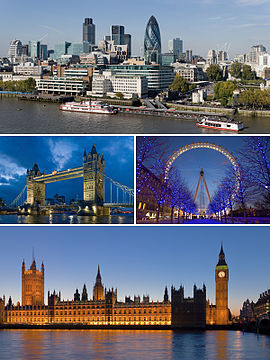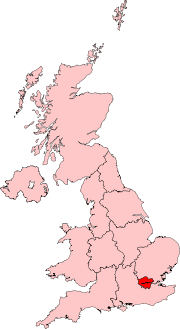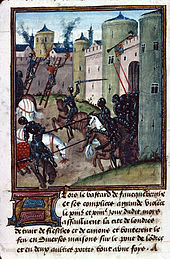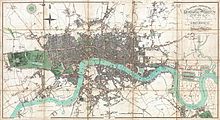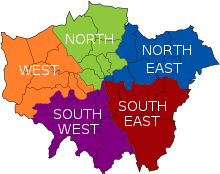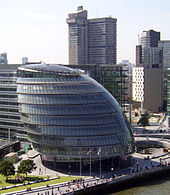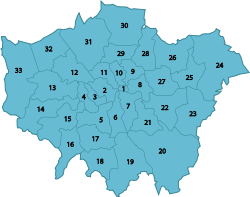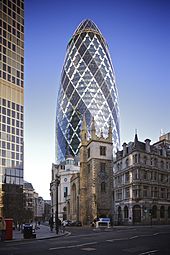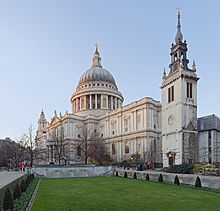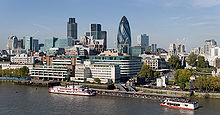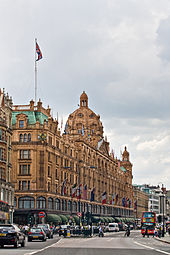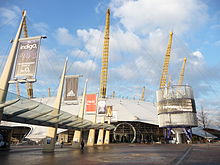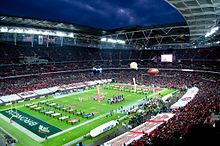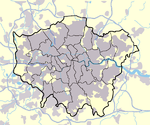- London
-
This article is about the capital of England and the United Kingdom. For other uses, see London (disambiguation).
London From upper left: City of London, Tower Bridge and London Eye, Palace of Westminster London region in the United Kingdom Coordinates: 51°30′26″N 0°7′39″W / 51.50722°N 0.1275°WCoordinates: 51°30′26″N 0°7′39″W / 51.50722°N 0.1275°W Sovereign state United Kingdom Constituent country England Region London Ceremonial counties City and Greater London Districts City and 32 boroughs Settled by Romans as Londinium, c. AD 43 Headquarters City Hall Government – Regional authority Greater London Authority – Regional assembly London Assembly – Mayor of London Boris Johnson – UK Parliament
- London Assembly
- European Parliament74 constituencies
14 constituencies
London constituencyArea – London 1,572.1 km2 (607 sq mi) Elevation[1] 24 m (79 ft) Population (July 2010 est.)[2] – London 7,825,200 – Density 4,978/km2 (12,892/sq mi) – Urban 8,278,251 – Metro 13,945,000 – Demonym Londoner – Ethnicity
(June 2009 estimates)Ethnic groupsTime zone GMT (UTC±0) – Summer (DST) BST (UTC+1) Postcode areas E , EC , N , NW , SE , SW , W , WC , BR , CM , CR , DA , EN , HA , IG , KT , RM , SM , TN , TW , UB
, WDArea code(s) 020, 01322, 01689, 01708, 01737, 01895, 01923, 01959, 01992 Website london.gov.uk London
 i/ˈlʌndən/ is the capital city of England and the United Kingdom, the largest metropolitan area in the United Kingdom, and the largest urban zone in the European Union by most measures.[note 1] Located on the River Thames, London has been a major settlement for two millennia, its history going back to its founding by the Romans, who called it Londinium.[3] London's ancient core, the City of London, largely retains its square-mile medieval boundaries. Since at least the 19th century, the name London has also referred to the metropolis developed around this core.[4] The bulk of this conurbation forms the London region[5] and the Greater London administrative area,[6][note 2] governed by the elected Mayor of London and the London Assembly.[7]
i/ˈlʌndən/ is the capital city of England and the United Kingdom, the largest metropolitan area in the United Kingdom, and the largest urban zone in the European Union by most measures.[note 1] Located on the River Thames, London has been a major settlement for two millennia, its history going back to its founding by the Romans, who called it Londinium.[3] London's ancient core, the City of London, largely retains its square-mile medieval boundaries. Since at least the 19th century, the name London has also referred to the metropolis developed around this core.[4] The bulk of this conurbation forms the London region[5] and the Greater London administrative area,[6][note 2] governed by the elected Mayor of London and the London Assembly.[7]London is a leading global city, with strengths in the arts, commerce, education, entertainment, fashion, finance, healthcare, media, professional services, research and development, tourism and transport all contributing to its prominence.[8] It is the world's largest financial centre alongside New York City[9][10][11] and has the fifth-largest city GDP in the world (and the largest in Europe).[12] It has the most international visitors of any city in the world[13] and London Heathrow is the world's busiest airport by number of international passengers.[14] London's 43 universities form the largest concentration of higher education in Europe.[15] In 2012 London will become the first city to host the modern Summer Olympic Games three times.[16]
London has a diverse range of peoples, cultures, and religions, and more than 300 languages are spoken within its boundaries.[17] In July 2010 Greater London had an official population of 7,825,200, making it the most populous municipality in the European Union.[2][18] The Greater London Urban Area is the second-largest in the EU with a population of 8,278,251,[19] while London's metropolitan area is the largest in the EU with an estimated total population of between 12 million[20] and 14 million.[21] London had the largest population of any city in the world from around 1831 to 1925.[22]
London contains four World Heritage Sites: the Tower of London; Kew Gardens; the site comprising the Palace of Westminster, Westminster Abbey, and St Margaret's Church; and the historic settlement of Greenwich (in which the Royal Observatory marks the Prime Meridian (0° longitude) and GMT).[23] Other famous landmarks include Buckingham Palace, the London Eye, Piccadilly Circus, St Paul's Cathedral, Tower Bridge, Trafalgar Square and Wembley Stadium. London is home to numerous museums, galleries, libraries, sporting events and other cultural institutions, including the British Museum, National Gallery, British Library, Wimbledon and 40 theatres.[24] The London Underground is the oldest underground railway network in the world[25] and the second-most extensive (after the Shanghai Metro).[26]
Contents
History
Main article: History of LondonToponymy
 The name London may derive from the River Thames
The name London may derive from the River Thames
The etymology of London is uncertain.[27] It is an ancient name and can be found in sources from the 2nd century. It is recorded c. 121 as Londinium, which points to Romano-British origin.[27] The earliest attempted explanation, now disregarded, is attributed to Geoffrey of Monmouth in Historia Regum Britanniae.[27] This had it that the name originated from a supposed King Lud, who had allegedly taken over the city and named it Kaerlud.[28]
From 1899 it was commonly accepted that the name was of Celtic origin and meant place belonging to a man called *Londinos; this explanation has since been rejected.[27] Richard Coates put forward an explanation in 1998 that it is derived from the pre-Celtic Old European *(p)lowonida, meaning 'river too wide to ford', and suggested that this was a name given to the part of the River Thames which flows through London; from this, the settlement gained the Celtic form of its name, *Lowonidonjon.[29]
Until 1889 the name "London" officially only applied to the City of London but since then it has also referred to the County of London and now Greater London.[4]
Prehistory and antiquity
Although there is evidence of scattered Brythonic settlements in the area, the first major settlement was founded by the Romans in 43 AD.[30] This lasted for just seventeen years and around 61, the Iceni tribe led by Queen Boudica stormed it, burning it to the ground.[31] The next, heavily planned incarnation of the city prospered and superseded Colchester as the capital of the Roman province of Britannia in 100. At its height during the 2nd century, Roman London had a population of around 60,000. By the 7th century, the Anglo-Saxons had created a new settlement called Lundenwic over a mile (2 km) upstream from the old Roman city, around what is now Covent Garden.[32]
It is likely that there was a harbour at the mouth of the River Fleet for fishing and trading, and this trading grew, until the city was overcome by the Vikings and forced to move east, back to the location of the Roman Londinium, in order to use its walls for protection.[33] Viking attacks continued to increase, until 886 when Alfred the Great recaptured London and made peace with the Danish leader, Guthrum.[34] The original Saxon city of Lundenwic became Ealdwic ("old city"), a name surviving to the present day as Aldwych, which is in the modern City of Westminster.[35]
Two recent discoveries indicate that London could be much older than previously thought. In 1999, the remains of a Bronze Age bridge were found on the foreshore north of Vauxhall Bridge.[36] This bridge either crossed the Thames, or went to a (lost) island in the river. Dendrology dated the timbers to 1500BC.
In 2010, the foundations of a large timber structure, dated to 4500BC, were found on the Thames foreshore, South of Vauxhall Bridge.[37] The function of the mesolithic structure is not known, but it covers at least 50m x 10m, and numerous 30 cm posts are visible at low tides. Both structures are on South Bank, at a natural crossing point where the River Effra flows into the River Thames, and 4 km upstream from the Roman City of London. The effort required to construct these structures implies trade, stability, and a community size of several hundred people at least.
Middle Ages
With the collapse of Roman rule in the early 5th century, London was effectively abandoned. However, from the 6th century an Anglo-Saxon settlement known as Lundenwic developed slightly to the west of the old Roman city, around what is now Covent Garden and the Strand, rising to a likely population of 10–12,000.[32] In the 9th century London was repeatedly attacked by Vikings, leading to a relocation of the city back to the location of Roman Londinium, in order to use its walls for protection.[33] Following the unification of England in the 10th century London, already the country's largest city and most important trading centre, became increasingly important as a political centre, although it still faced competition from Winchester, the traditional centre of the kingdom of Wessex.
In the 11th century King Edward the Confessor re-founded and rebuilt Westminster Abbey and Westminster, a short distance upstream from London became a favoured royal residence. From this point onward Westminster steadily supplanted the City of London itself as a venue for the business of national government.[38]
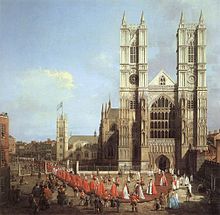 Westminster Abbey is a World Heritage Site and one of London's oldest and most important buildings as seen in this painting (Canaletto, 1749 A.D.)
Westminster Abbey is a World Heritage Site and one of London's oldest and most important buildings as seen in this painting (Canaletto, 1749 A.D.)
Following his victory in the Battle of Hastings, William, Duke of Normandy, was crowned King of England in the newly finished Westminster Abbey on Christmas Day 1066.[39] William constructed the Tower of London, the first of the many Norman castles in England to be rebuilt in stone, in the southeastern corner of the city to intimidate the native inhabitants.[40] In 1097, William II began the building of Westminster Hall, close by the abbey of the same name. The hall became the basis of a new Palace of Westminster.[41][42]
During the 12th century the institutions of central government, which had hitherto accompanied the royal court as it moved around the country, grew in size and sophistication and became increasingly fixed in one place. In most cases this was Westminster, although the royal treasury, having been moved from Winchester, came to rest in the Tower. While the City of Westminster developed into a true capital in governmental terms, its distinct neighbour, the City of London, remained England's largest city and principal commercial centre and flourished under its own unique administration, the Corporation of London. In 1100 its population was around 18,000; by 1300 it had grown to nearly 100,000.[43]
Disaster struck during the Black Death in the mid-14th century, when London lost nearly a third of its population.[44] London was the focus of the Peasants' Revolt in 1381.[45]
Early modern
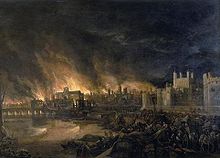 The Great Fire of London destroyed many parts of the city in 1666.
The Great Fire of London destroyed many parts of the city in 1666.
During the Tudor period the Reformation produced a gradual shift to Protestantism, with much of London passing from church to private ownership.[46] Mercantilism grew and monopoly trading companies such as the East India Company were established, with trade expanding to the New World. London became the principal North Sea port, with migrants arriving from England and abroad. The population rose from an estimated 50,000 in 1530 to about 225,000 in 1605.[46]
In the 16th century William Shakespeare and his contemporaries lived in London at a time of hostility to the development of the theatre. By the end of the Tudor period in 1603, London was still very compact. There was an assassination attempt on James I in Westminster, through the Gunpowder Plot on 5 November 1605.[47] London was plagued by disease in the early 17th century,[48] culminating in the Great Plague of 1665–1666, which killed up to 100,000 people, or a fifth of the population.[49]
The Great Fire of London broke out in 1666 in Pudding Lane in the city and quickly swept through the wooden buildings.[50] Rebuilding took over ten years and was supervised by Robert Hooke[51][52][53] as Surveyor of London.[54] In 1708 Christopher Wren's masterpiece, St Paul's Cathedral was completed. During the Georgian era new districts such as Mayfair were formed in the west; and new bridges over the Thames encouraged development in South London. In the east, the Port of London expanded downstream.
In 1762 George III acquired Buckingham House and it was enlarged over the next 75 years. During the 18th century, London was dogged by crime and the Bow Street Runners were established in 1750 as a professional police force.[55] In total, more than 200 offences were punishable by death,[56] and women and children were hanged for petty theft.[57] Over 74 per cent of children born in London died before they were five.[58] The coffeehouse became a popular place to debate ideas, with growing literacy and the development of the printing press making news widely available; and Fleet Street became the centre of the British press.
“ You find no man, at all intellectual, who is willing to leave London. No, Sir, when a man is tired of London, he is tired of life; for there is in London all that life can afford. ” —Samuel Johnson, 1777[59]
Late modern and contemporary
 A London street hit during the Blitz of World War II
A London street hit during the Blitz of World War II
London was the world's largest city from about 1831 to 1925.[22] London's overcrowded conditions led to cholera epidemics,[60] claiming 14,000 lives in 1848, and 6,000 in 1866.[61] Rising traffic congestion led to the creation of the world's first local urban rail network. The Metropolitan Board of Works oversaw infrastructure expansion. It was replaced in 1889 by the London County Council, London's first elected city-wide administration. The Blitz and other bombing by the German Luftwaffe during World War II killed over 30,000 Londoners and destroyed large tracts of housing and other buildings across London. Immediately after the war, the 1948 Summer Olympics were held at the original Wembley Stadium, at a time when the city had barely recovered from the war.
In 1951 the Festival of Britain was held on the South Bank. The Great Smog of 1952 led to the Clean Air Act 1956, which ended the "pea-souper" fogs for which London had been notorious. From the 1950s onwards, London became home to a large number of immigrants, largely from Commonwealth countries such as Jamaica, India, Bangladesh and Pakistan, making London one of the most diverse cities in Europe.
Starting in the mid-1960s, London became a centre for the worldwide youth culture, exemplified by the Swinging London subculture associated with Carnaby Street. The role of trendsetter was revived during the punk era. In 1965 London's political boundaries were expanded to take into account the growth of the urban area and a new Greater London Council was created. During The Troubles in Northern Ireland, London was subjected to bombing attacks by the Provisional IRA. Racial inequality was highlighted by the 1981 Brixton riot. Greater London's population declined steadily in the decades after World War II, from an estimated peak of 8.6 million in 1939 to around 6.8 million in the 1980s. The principal ports for London moved downstream to Felixstowe and Tilbury, with the London Docklands area becoming a focus for regeneration as the Canary Wharf development. This was borne out of London's ever-increasing role as a major international financial centre during the 1980s.
The Thames Barrier was completed in the 1980s to protect London against tidal surges from the North Sea. The Greater London Council was abolished in 1986, which left London as the only large metropolis in the world without a central administration. In 2000, London-wide government was restored, with the creation of the Greater London Authority. To celebrate the start of the 21st century, the Millennium Dome, London Eye and Millennium Bridge were constructed. On 7 July 2005, three London Underground trains and a double-decker bus were bombed in a series of terrorist attacks.[62]
Government
Local government
Main articles: Local government in London, History of local government in London, and List of heads of London governmentThe administration of London is formed of two tiers—a city-wide, strategic tier and a local tier. City-wide administration is coordinated by the Greater London Authority (GLA), while local administration is carried out by 33 smaller authorities.[63] The GLA consists of two elected components; the Mayor of London, who has executive powers, and the London Assembly, who scrutinise the mayor's decisions and can accept or reject his budget proposals each year. The headquarters of the GLA is City Hall, Southwark; the current mayor is Boris Johnson. The mayor's statutory planning strategy is published as the London Plan, which as of mid-2009[update] is being revised, for final publication in 2011. The local authorities are the councils of the 32 London boroughs and the City of London Corporation.[64] They are responsible for most local services, such as local planning, schools, social services, local roads and refuse collection. Certain functions, such as waste management, are provided through joint arrangements. In 2009-2010 the combined revenue expenditure by london councils and the GLA amounted to just over 22 billion ₤ (14.7 billion ₤ for the boroughs and 7.4 billion ₤ for the GLA)[65]
Policing in Greater London, with the exception of the City of London, is provided by the Metropolitan Police Force, overseen by the Metropolitan Police Authority. The City of London has its own police force – the City of London Police.[66] The British Transport Police are responsible for police services on National Rail and London Underground services in the capital.[67]
The London Fire Brigade is the statutory fire and rescue service for Greater London. It is run by the London Fire and Emergency Planning Authority and is the third-largest fire service in the world.[68] National Health Service ambulance services are provided by the London Ambulance Service (LAS) NHS Trust, the largest free at the point of use emergency ambulance service in the world.[69] The London Air Ambulance charity operates in conjunction with the LAS where required. Her Majesty's Coastguard and the Royal National Lifeboat Institution operate on the River Thames.[70][71]
National government
London is the seat of the Government of the United Kingdom, which is located around the Palace of Westminster. Many government departments are located close to Parliament, particularly along Whitehall, including the Prime Minister's residence at 10 Downing Street.[72] The British Parliament is often referred to as the "Mother of Parliaments" (although this sobriquet was first applied to England itself by John Bright)[73] because it has been the model for most other parliamentary systems, and its Acts have created many other parliaments.
Geography
Main article: Geography of LondonScope
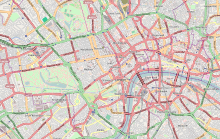 Map of central London
Map of central London
Greater London is the top-level administrative subdivision covering London. The small, ancient City of London at its core once contained the whole settlement, but as the urban area grew the City Corporation resisted attempts to amalgamate it with its suburbs, causing "London" to be defined in a number ways for different purposes; and the situation was once open to legal debate.[74] Forty per cent of Greater London is covered by the London post town, within which 'LONDON' forms part of postal addresses.[75][76]
The London telephone area code (020) covers a larger area, similar in size to Greater London, although some outer districts are omitted and some places just outside are included. The area within the orbital M25 motorway is normally what is referred to as 'London'.[77] and the Greater London boundary has been aligned to it in places.[78]
Outward urban expansion is now prevented by the Metropolitan Green Belt,[79] although the built-up area extends beyond the boundary in places, resulting in a separately defined Greater London Urban Area. Beyond this is the vast London commuter belt.[80] Greater London is split for some purposes into Inner London and Outer London.[81] The city is split by the River Thames into North and South, with an informal central London area in its interior. The coordinates of the nominal centre of London, traditionally considered to be the original Eleanor Cross at Charing Cross near the junction of Trafalgar Square and Whitehall, are approximately 51°30′26″N 00°07′39″W / 51.50722°N 0.1275°W.[82]

Panorama of London, taken from the Golden Gallery of St Paul's Cathedral Status
Within London, both the City of London and the City of Westminster have city status and both the City of London and the remainder of Greater London are the ceremonial counties.[83] The current area of Greater London has incorporated areas that were once part of the counties of Middlesex, Kent, Surrey, Essex and Hertfordshire.[84] London's status as the capital of England, and later the United Kingdom, has never been granted or confirmed officially—by statute or in written form.[note 3]
Its position was formed through constitutional convention, making its status as de facto capital a part of the UK's unwritten constitution. The capital of England was moved to London from Winchester as the Palace of Westminster developed in the 12th and 13th centuries to become the permanent location of the royal court, and thus the political capital of the nation.[88] More recently, Greater London has been defined as a region of England and in this context known as London.[5]
Topography
Greater London covers an area of 1,583 square kilometres (611 sq mi), an area which had a population of 7,172,036 in 2001 and a population density of 4,542 inhabitants per square kilometre (11,760 /sq mi). A larger area, referred to as the London Metropolitan Region or the London Metropolitan Agglomeration covers an area of 8,382 square kilometres (3,236 sq mi) has a population of 12,653,500 and a population density of 1,510 inhabitants per square kilometre (3,900 /sq mi).[89] Modern London stands on the Thames, its primary geographical feature, a navigable river which crosses the city from the south-west to the east. The Thames Valley is a floodplain surrounded by gently rolling hills including Parliament Hill, Addington Hills, and Primrose Hill. The Thames was once a much broader, shallower river with extensive marshlands; at high tide, its shores reached five times their present width.[90]
Since the Victorian era the Thames has been extensively embanked, and many of its London tributaries now flow underground. The Thames is a tidal river, and London is vulnerable to flooding.[91] The threat has increased over time due to a slow but continuous rise in high water level by the slow 'tilting' of Britain (up in the north and down in the south) caused by post-glacial rebound.[92]
In 1974, a decade of work began on the construction of the Thames Barrier across the Thames at Woolwich to deal with this threat. While the barrier is expected to function as designed until roughly 2070, concepts for its future enlargement or redesign are already being discussed.[93]
Climate
London has a temperate oceanic climate, similar to much of southern Britain. Despite its reputation as being a rainy city, London interestingly receives less precipitation in a year than Rome at 834 mm (32.8 in), or Bordeaux at 923 mm (36.3 in), do.[94] Winters are generally chilly to cold with frost usually occurring in the suburbs on average twice a week from November to March. Snow usually occurs about 4 or 5 times a year mostly from December to February. Snowfall during March and April is rare but does occur every 2–3 years. Winter temperatures seldom fall below −7 °C (19.4 °F) or rise above 8 °C (46.4 °F). During the winter of 2010, London experience its lowest temperature on record (-14C) in Northolt and the heaviest snow seen for almost two decades, a huge strain on London's transport infrastructure. Summers are generally warm and sometimes hot, the heat being boosted by the "Urban Heat Island Effect" making the centre of London at times 5 °C (41.0 °F) warmer than the suburbs and outskirts. London's summer average is a comfortable 24 °C (75.2 °F). On average there are 7 days a year above 30 °C (86.0 °F) and 2 days a year above 32 °C (89.6 °F). During the 2003 European Heat Wave there were 14 consecutive days above 30 °C (86.0 °F) and 2 consecutive days where temperatures soared up to 37 °C (98.6 °F), leading to hundreds of heat related deaths. Rain generally occurs on around 2 out of 10 summer days. Temperature extremes range from -10C(14F) to 37.9C(100.22F).
London Climate chart (explanation) J F M A M J J A S O N D 5582418242114441464918945211245241450231449201169168591155583Average max. and min. temperatures in °C Precipitation totals in mm Imperial conversion J F M A M J J A S O N D 2.247361.647361.653391.758421.964481.870531.874571.974571.968532.760472.352412.24737Average max. and min. temperatures in °F Precipitation totals in inches Climate data for London (Greenwich) Month Jan Feb Mar Apr May Jun Jul Aug Sep Oct Nov Dec Year Record high °C (°F) 14.0
(57.2)16.0
(60.8)21.0
(69.8)26.9
(80.4)31.0
(87.8)35.0
(95.0)35.5
(95.9)37.9
(100.2)30.0
(86.0)28.8
(83.8)19.0
(66.2)15.0
(59.0)37.9
(100.2)Average high °C (°F) 8.1
(46.6)8.4
(47.1)11.4
(52.5)14.2
(57.6)17.9
(64.2)21.1
(70.0)23.5
(74.3)23.2
(73.8)19.9
(67.8)15.6
(60.1)11.2
(52.2)8.3
(46.9)15.2 Average low °C (°F) 2.3
(36.1)2.1
(35.8)3.9
(39.0)5.5
(41.9)8.7
(47.7)11.7
(53.1)13.9
(57.0)13.7
(56.7)11.4
(52.5)8.4
(47.1)4.9
(40.8)2.7
(36.9)7.4 Record low °C (°F) −10
(14.0)−9
(15.8)−8
(17.6)−2
(28.4)−1
(30.2)5.0
(41.0)7.0
(44.6)6.0
(42.8)3.0
(37.4)−4
(24.8)−5
(23.0)−7
(19.4)−10
(14.0)Precipitation mm (inches) 55.2
(2.173)40.8
(1.606)41.6
(1.638)43.6
(1.717)49.3
(1.941)44.9
(1.768)44.5
(1.752)49.5
(1.949)49.1
(1.933)68.5
(2.697)59.0
(2.323)55.0
(2.165)601.5
(23.681)Snowfall cm (inches) 24.4
(9.61)10.8
(4.25)2.7
(1.06)0.4
(0.16)0
(0)0
(0)0
(0)0
(0)0
(0)0
(0)0.2
(0.08)8.2
(3.23)46.7
(18.39)% humidity 91 89 91 90 92 92 93 95 96 95 93 91 92.3 Avg. rainy days (≥ 1 mm) 10.9 8.1 9.8 9.3 8.5 8.4 7.0 7.2 8.7 9.3 9.3 10.1 106.6 Avg. snowy days 4 4 3 1 0 0 0 0 0 0 1 3 16 Sunshine hours 45.9 66.1 103.2 147.0 185.4 180.6 190.3 194.4 139.2 109.7 60.6 37.8 1,460.2 Source no. 1: Record highs and lows from BBC Weather,[95] except August maximum from Met Office[96] Source no. 2: All other data from Met Office,[97] except for humidity and snow data which are from NOAA[98] Districts
Main article: List of districts of LondonThe City of London and the 32 London boroughs London's vast urban area is often described using a set of district names, such as Bloomsbury, Mayfair, Wembley and Whitechapel. These are either informal designations, reflect the names of villages that have been absorbed by sprawl, or are superseded administrative units such as parishes or former boroughs.
Such names have remained in use through tradition, each referring to a local area with its own distinctive character, but without current official boundaries. Since 1965 Greater London has been divided into 32 London boroughs in addition to the ancient City of London.[99][100] The City of London is the main financial district[101] and Canary Wharf has recently developed into a new financial and commercial hub, in the Docklands to the east.
The West End is London's main entertainment and shopping district, attracting tourists.[102] West London includes expensive residential areas where properties can sell for tens of millions of pounds.[103] The average price for properties in Kensington and Chelsea is £894,000 with similar average outlay in most of central London.[104]
The East End is the area closest to the original Port of London, known for its high immigrant population, as well as for being one of the poorest areas in London.[105] The surrounding East London area saw much of London's early industrial development; now, brownfield sites throughout the area are being redeveloped as part of the Thames Gateway including the London Riverside and Lower Lea Valley, which is being developed into the Olympic Park for the 2012 Olympics and Paralympics.[105]
Architecture
Main articles: Architecture of London and List of tallest buildings and structures in LondonLondon's buildings are too diverse to be characterised by any particular architectural style, and have been built over a long period of time. Many grand houses and public buildings, such as the National Gallery, are constructed from Portland stone. Some areas of the city, particularly those just west of the centre, are characterised by white stucco or whitewashed buildings. Few structures pre-date the Great Fire of 1666, except for a few trace Roman remains, the Tower of London and a few scattered Tudor survivors in the City. One notable building that remains from the Tudor period is Hampton Court Palace, which is England's oldest surviviving Tudor palace, built by Cardinal Thomas Wolsey circa 1515.[106] Wren's late 17th century churches and the financial institutions of the 18th and 19th centuries such as the Royal Exchange and the Bank of England, to the early 20th century Old Bailey and the 1960s Barbican Estate form part of the varied architectural heritage.
The disused, but soon to be rejuvenated, 1939 Battersea Power Station by the river in the southwest is a local landmark, while some railway termini are excellent examples of Victorian architecture, most notably St. Pancras and Paddington.[107] The density of London varies, with high employment density in the central area, high residential densities in inner London and lower densities in the suburbs.
The Monument in the City of London provides views of the surrounding area while commemorating the Great Fire of London, which originated nearby. Marble Arch and Wellington Arch, at the north and south ends of Park Lane respectively, have royal connections, as do the Albert Memorial and Royal Albert Hall in Kensington. Nelson's Column is a nationally recognised monument in Trafalgar Square, one of the focal points of the city centre.
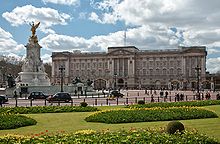 Buckingham Palace is the official residence of the British monarch
Buckingham Palace is the official residence of the British monarch
High-rise development is restricted at certain sites if it would obstruct protected views of St Paul's Cathedral. Nevertheless, there are plans for more skyscrapers in central London (see Tall buildings in London), including the 72-storey Shard London Bridge which is currently under construction. Development temporarily stalled as a result of the recent financial crisis, but is reported to be recovering.[108] Older buildings are mainly brick built, most commonly the yellow London stock brick or a warm orange-red variety, often decorated with carvings and white plaster mouldings.[109]
In the dense areas, most of the concentration is achieved with medium- and high-rise buildings. London's skyscrapers such as 30 St Mary Axe, Tower 42, the Broadgate Tower and One Canada Square are usually found in the two financial districts, the City of London and Canary Wharf. Other notable modern buildings include City Hall in Southwark with its distinctive oval shape,[110] and the British Library in Somers Town/Kings Cross. What was formerly the Millennium Dome, located by the Thames to the east of Canary Wharf, is now used as an entertainment venue called The O2 Arena.
Parks and gardens
Main articles: Parks and open spaces in London and Royal Parks of London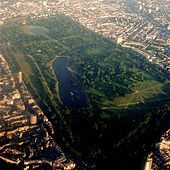 Aerial view of Hyde Park
Aerial view of Hyde Park
The largest parks in the central area of London are the Royal Parks of Hyde Park, its neighbour Kensington Gardens at the western edge of central London and Regent's Park on the northern edge.[111] Regent's Park contains London Zoo, the world's oldest scientific zoo, and is located near the tourist attraction of Madame Tussauds Wax Museum.[112][113]
Closer to central London are the smaller Royal Parks of Green Park and St. James's Park.[114] Hyde Park in particular is popular for sports and sometimes hosts open-air concerts. A number of large parks lie outside the city centre, including the remaining Royal Parks of Greenwich Park to the south-east[115] and Bushy Park and Richmond Park to the south-west,[116][117] as well as Victoria Park, East London to the east. Primrose Hill to the north of Regent's Park is a popular spot to view the city skyline.
Some more informal, semi-natural open spaces also exist, including the 320-hectare (790-acre) Hampstead Heath of North London.[118] This incorporates Kenwood House, the former stately home and a popular location in the summer months where classical musical concerts are held by the lake, attracting thousands of people every weekend to enjoy the music, scenery and fireworks.[119]
Demography
Main article: Demography of London2001 United Kingdom Census[120] Country of birth Population  United Kingdom
United Kingdom5,230,155  India
India172,162  Republic of Ireland
Republic of Ireland157,285  Bangladesh
Bangladesh84,565  Jamaica
Jamaica80,319  Nigeria
Nigeria68,907  Pakistan
Pakistan66,658  Kenya
Kenya66,311  Sri Lanka
Sri Lanka49,932  Ghana
Ghana46,513  Cyprus
Cyprus45,888  South Africa
South Africa45,506  United States
United States44,622  Australia
Australia41,488  Germany
Germany39,818  Turkey
Turkey39,128  Italy
Italy38,694  France
France38,130  Somalia
Somalia33,831  Uganda
Uganda32,082  New Zealand
New Zealand27,494 2009–10 ONS estimates[121] Country of birth Population  India
India248,000  Poland
Poland122,000  Republic of Ireland
Republic of Ireland110,000  Bangladesh
Bangladesh107,000  Nigeria
Nigeria95,000
With increasing industrialisation, London's population grew rapidly throughout the 19th and early 20th centuries, and it was for some time in the late 19th and early 20th centuries the most populous city in the world until overtaken by New York in 1925. Its population peaked at 8,615,245 in 1939 immediately before the outbreak of the Second World War. There were an estimated 7,556,900 official residents in Greater London as of mid-2007[update].[122]However, London's continuous urban area extends beyond the borders of Greater London and was home to 8,278,251 people in 2001,[19] while its wider metropolitan area has a population of between 12 and 14 million depending on the definition used.[123] According to Eurostat, London is the most populous city and metropolitan area of the European Union and the second most populous in Europe (or third if Istanbul is included). During the period 1991–2001 a net 726,000 immigrants arrived in London.[124]
The region covers an area of 1,579 square kilometres (610 sq mi). The population density is 4,542 inhabitants per square kilometre (11,760 /sq mi),[125] more than ten times that of any other British region.[126] In terms of population, London is the 25th largest city and the 18th largest metropolitan region in the world. It is also ranked 4th in the world in number of billionaires (United States Dollars) residing in the city.[127] London ranks as one of the most expensive cities in the world, alongside Tokyo and Moscow.[128]
Ethnic groups
Main article: Ethnic groups in LondonAccording to the Office for National Statistics, based on 2009 estimates, 69.7 per cent of the 7,753,600 inhabitants of London were White, with 59.5 per cent White British, 2.2 per cent White Irish and 8.0 per cent classified as Other White. Some 13.2 per cent are of South Asian descent, with Indians making up 6.2 per cent of London's population, followed by Pakistanis and Bangladeshis at 2.8 per cent and 2.2 per cent respectively. 2.0 per cent are categorised as "Other Asian". 10.1 per cent of London's population are Black, with around 5.3 per cent being Black African, 4.0 per cent as Black Caribbean and 0.8 per cent as "Other Black". 3.5 per cent of Londoners are of mixed race; 1.8 per cent are Chinese; and 1.7 per cent belong to another ethnic group.[129]
Across London, Black and Asian children outnumber White British children by about six to four in state schools.[130] However, White children represent 62 per cent of London's 1,498,700 population aged 0 to 15 as of 2009 estimates from the Office for National Statistics, with 55.7 per cent of the population aged 0 to 15 being White British, 0.7 per cent being White Irish and 5.6 per cent being from other EU White backgrounds.[131] In January 2005, a survey of London's ethnic and religious diversity claimed that there were more than 300 languages spoken and more than 50 non-indigenous communities which have a population of more than 10,000 in London.[132] Figures from the Office for National Statistics show that, as of 2010[update], London's foreign-born population is 2,650,000 (33 per cent), up from 1,630,000 in 1997.
The 2001 census showed that 27.1 per cent of Greater London's population were born outside the UK.[133] The table to the right shows the 20 most common foreign countries of birth of London residents in 2001, the date of the last published UK Census.[120] A portion of the German-born population are likely to be British nationals born to parents serving in the British Armed Forces in Germany.[134] Estimates produced by the Office for National Statistics indicate that the five largest foreign-born groups living in London in the period July 2009 to June 2010 were those born in India, Poland, the Republic of Ireland, Bangladesh and Nigeria.[121]
Religion
Main article: Religion in LondonThe majority of Londoners – 58.2 per cent – identify themselves as Christians.[135] This is followed by those of no religion (15.8 per cent), Muslims (8.5 per cent), Hindus (4.1 per cent), Jews (2.1 per cent), Sikhs (1.5 per cent), Buddhists (0.8 per cent) and other (0.2 per cent), though 8.7 per cent of people did not answer this question in the 2001 Census.[135]
London has traditionally been Christian, and has a large number of churches, particularly in the City of London. The well-known St Paul's Cathedral in the City and Southwark Cathedral south of the river are Anglican administrative centres,[136] while the Archbishop of Canterbury, principal bishop of the Church of England and worldwide Anglican Communion, has his main residence at Lambeth Palace in the London Borough of Lambeth.[137]
Important national and royal ceremonies are shared between St Paul's and Westminster Abbey.[138] The Abbey is not to be confused with nearby Westminster Cathedral, which is the largest Roman Catholic cathedral in England and Wales.[139] Despite the prevalence of Anglican churches, observance is very low within the Anglican denomination. Church attendance continues on a long, slow, steady decline, according to Church of England statistics.[140]
London is also home to sizeable Muslim, Hindu, Sikh, and Jewish communities. Many Muslims live in Tower Hamlets and Newham; the most important Muslim edifice is London Central Mosque on the edge of Regent's Park.[141] Following the oil boom, increasing numbers of wealthy Middle-Eastern Muslims have based themselves around Mayfair and Knightsbridge in west London.[142][143] London is home to the largest mosque in western Europe, the Baitul Futuh Mosque, of the Ahmadiyya Muslim Community London's large Hindu community is found in the north-western boroughs of Harrow and Brent, the latter of which is home to one of Europe's largest Hindu temples, Neasden Temple.[144] Sikh communities are located in East and West London, which is also home to the largest Sikh temple in the world outside India.[145]
The majority of British Jews live in London, with significant Jewish communities in Stamford Hill, Stanmore, Golders Green, Hampstead, Hendon and Edgware in North London. Stanmore and Canons Park Synagogue has the largest membership of any single Orthodox synagogue in the whole of Europe, overtaking Ilford synagogue (also in London) in 1998.[146] The community set up the London Jewish Forum in 2006 in response to the growing significance of devolved London Government.[147]
Economy
Main articles: Economy of London and Media in LondonLondon generates approximately 20 per cent of the UK's GDP[148] (or $446 billion in 2005); while the economy of the London metropolitan area—the largest in Europe—generates approximately 30 per cent of the UK's GDP (or an estimated $669 billion in 2005).[149] London is one of the pre-eminent financial centres of the world and vies with New York City as the most important location for international finance.[150][151]
London's largest industry is finance, and its financial exports make it a large contributor to the UK's balance of payments. Around 325,000 people were employed in financial services in London until mid-2007. London has over 480 overseas banks, more than any other city in the world. Currently, over 85% (3.2 million) of the employed population of greater London works in the services industries. Due to its prominent global role, London's economy has been affected by the late-2000s financial crisis. The City of London estimates that 70,000 jobs in finance will be cut within a year.[152] The City of London is home to the Bank of England, London Stock Exchange, and Lloyd's of London insurance market.
Over half of the UK's top 100 listed companies (the FTSE 100) and over 100 of Europe's 500 largest companies are headquartered in central London. Over 70 per cent of the FTSE 100 are located within London's metropolitan area, and 75 per cent of Fortune 500 companies have offices in London.[153]
 Canary Wharf is a major business and financial centre and is home to some of the UK's tallest buildings
Canary Wharf is a major business and financial centre and is home to some of the UK's tallest buildings
Along with professional services, media companies are concentrated in London and the media distribution industry is London's second most competitive sector.[154] The BBC is a significant employer, while other broadcasters also have headquarters around the City. Many national newspapers are edited in London. London is a major retail centre and in 2010 had the highest non-food retail sales of any city in the world, with a total spend of around £64.2 billion.[155] The Port of London is the second-largest in the United Kingdom, handling 45 million tonnes of cargo each year.[156]
London has five major business districts: the City, Westminster, Canary Wharf, Camden & Islington and Lambeth & Southwark. One way to get an idea of their relative importance is to look at relative amounts of office space: Greater London had 27 million m2 of office space in 2001, and the City contains the most space, with 8 million m2 of office space.
Tourism
Main article: Tourism in LondonTourism is one of London's prime industries and employs the equivalent of 350,000 full-time workers in London in 2003,[157] while annual expenditure by tourists is around £15 billion.[158] London attracts over 14 million international visitors per year, making it the world's most visited city.[13] London attracts 27 million overnight-stay visitors every year.[159]
In 2009 the ten most-visited attractions in London were:[160]
- British Museum
- National Gallery
- Tate Modern
- Natural History Museum
- London Eye
- Science Museum
- Tower of London
- National Maritime Museum
- Victoria and Albert Museum
- Madame Tussauds
Transport
Main article: Transport in LondonTransport is one of the four main areas of policy administered by the Mayor of London,[161] however the mayor's financial control does not extend to the longer distance rail network that enters London. In 2007 he assumed responsibility for some local lines, which now form the London Overground network, adding to the existing responsibility for the London Underground, trams and buses. The public transport network is administered by Transport for London (TfL) and is one of the most extensive in the world. Cycling is an increasingly popular way to get around London. The London Cycling Campaign lobbies for better provision.[162]
The lines that formed the London Underground, as well as trams and buses, became part of an integrated transport system in 1933 when the London Passenger Transport Board (LPTB) or London Transport was created. Transport for London (TfL), is now the statutory corporation responsible for most aspects of the transport system in Greater London, and is run by a board and a commissioner appointed by the Mayor of London.[163]
Air
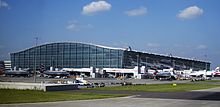 Heathrow (terminal 5 pictured) is the busiest airport in the world for international traffic.[14][164]
Heathrow (terminal 5 pictured) is the busiest airport in the world for international traffic.[14][164]
London is a major international air transport hub with the largest city airspace in the world. Eight airports use the word London in their name, but most traffic passes through six of these. London Heathrow Airport, in Hillingdon, West London, is the busiest airport in the world for international traffic, and is the major hub of the nation's flag carrier, British Airways.[165] In March 2008 its fifth terminal was opened.[166] There were plans for a third runway and a sixth terminal however these were cancelled by the Coalition Government on 12 May 2010.[167] Similar traffic, with the addition of some low-cost short-haul flights, is also handled at London Gatwick Airport, located south of London in West Sussex.[168]
Stansted Airport, situated north east of London in Essex, is the main UK hub for Ryanair and Luton Airport to the north of London in Bedfordshire, caters mostly for low-cost short-haul flights.[169][170] London City Airport, the smallest and most central airport, is focused on business travellers, with a mixture of full service short-haul scheduled flights and considerable business jet traffic.[171]
London Southend Airport, east of London in Essex, is a smaller, regional airport that mainly caters for low-cost short-haul flights. It recently went through a large redevelopment project including a brand new terminal, extended runway and a new train station offering fast links into the capital. EasyJet currently have a base at the airport.
Buses and trams
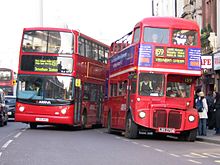 The red double-decker bus is an iconic symbol of London
The red double-decker bus is an iconic symbol of London
London's bus network is one of the largest in the world, running 24 hours a day, with 8,000 buses, 700 bus routes, and over 6 million passenger journeys made every weekday. In 2003, the network's ridership was estimated at over 1.5 billion passenger trips per annum, more than the Underground.[172] Around £850 million is taken in revenue each year. London has the largest wheelchair accessible network in the world[173] and, from the 3rd quarter of 2007, became more accessible to hearing and visually impaired passengers as audio-visual announcements were introduced. The distinctive red double-decker buses are internationally recognised, and are a trademark of London transport along with black cabs and the Tube.[174][175]
London has a modern tram network, known as Tramlink, based in Croydon in South London. The network has 39 stops, three routes and carried 26.5 million people in 2008. Since June 2008 Transport for London has completely owned Tramlink and plans to spend £54m by 2015 on maintenance, renewals, upgrades and capacity enhancements. Since April 2009 all trams have been refurbished.[176]
Cycling
Main article: Cycling in LondonCycling in London has enjoyed a renaissance since the turn of the Millennium. Cyclists enjoy a cheaper, and often quicker, way around town than those by public transport or car, and the launch of the Barclays Cycle Hire scheme in July 2010 has been successful and generally well-received.
Port
From being the largest port in the world, the Port of London is now only the second-largest in the United Kingdom, handling 45 million tonnes of cargo each year.[156] Most of this actually passes through the Port of Tilbury, outside the boundary of Greater London.
Rail
The London Underground — all of which is now commonly referred to as the Tube, though originally this designation referred only to the deep-level lines, as distinct from the sub-surface lines — is the oldest,[25] and second longest[26] metro system in the world, dating from 1863. The system serves 270 stations[177] and was formed from several private companies, including the world's first underground electric line, the City and South London Railway.[178]
Over three million journeys are made every day on the Underground network, over 1 billion each year.[179] An investment programme is attempting to address congestion and reliability problems, including £7 billion (€10 billion) of improvements planned for the 2012 Summer Olympics.[180] London has been commended as the city with the best public transport.[181] The Docklands Light Railway, which opened in 1987, is a second, more local metro system using smaller and lighter tram-type vehicles which serve Docklands and Greenwich.
There is an extensive above-ground suburban railway network, particularly in South London, which has fewer Underground lines. London houses Britain's busiest station – Waterloo with over 184 million people using the interchange station complex (which includes Waterloo East station) each year. The stations have services to South East and South West London, and also parts of South East and South West England.[182][183] Most rail lines terminate around the centre of London, running into eighteen terminal stations with the exception of the Thameslink trains connecting Bedford in the north and Brighton in the south via Luton and Gatwick airports.[184]
Since 2007 high-speed Eurostar trains link St. Pancras International with Lille, Paris, and Brussels. Journey times to Paris and Brussels of two-and-a-quarter hours and one hour 50 minutes respectively make London closer to continental Europe than the rest of Britain by virtue of the High Speed 1 rail link to the Channel Tunnel[185] while the first high speed domestic trains started in June 2009 linking Kent to London.[186]
Roads
Although the majority of journeys involving central London are made by public transport, car travel is common in the suburbs. The inner ring road (around the city centre), the North and South Circular roads (in the suburbs), and the outer orbital motorway (the M25, outside the built-up area) encircle the city and are intersected by a number of busy radial routes—but very few motorways penetrate into inner London. The M25 is the longest ring-road motorway in the world at 195.5 km (121.5 mi) long.[187] The A1 and M1 connect London to Edinburgh, Leeds and Newcastle.
A plan for a comprehensive network of motorways throughout the city (the Ringways Plan) was prepared in the 1960s but was mostly cancelled in the early 1970s. In 2003, a congestion charge was introduced to reduce traffic volumes in the city centre. With a few exceptions, motorists are required to pay £10 per day to drive within a defined zone encompassing much of congested central London.[188][189] Motorists who are residents of the defined zone can buy a vastly reduced season pass which is renewed monthly and is cheaper than a corresponding bus fare.[190] London is notorious for its traffic congestion, with the M25 motorway the busiest stretch in the country. The average speed of a car in the rush hour is 10.6 mph (17.1 km/h).[191] London government initially anticipated the Congestion Charge Zone to increase daily peak period Underground and bus users by 20,000 people, reduce traffic by ten to fifteen percent, increase traffic speeds by ten to fifteen percent, and reduce queues by twenty to thirty percent.[192] Over the course of several years, the average number of cars entering the centre of London on a weekday was reduced from 195,000 to 125,000 cars – this is a 35-percent reduction of vehicles driven per day.[193]
Education
Main article: Education in LondonTertiary education
London is a major centre of higher education teaching and research and its 43 universities form the largest concentration of higher education in Europe.[15] In 2008/09 it had a higher education student population of around 412,000 (approximately 17 per cent of the UK total), of whom around 287,000 were registered for undergraduate degrees and 118,000 were studying at postgraduate level.[194] In 2008/09 there were around 97,150 international students in London, approximately 25 per cent of all international students in the UK.[194]
A number of world-leading education institutions are based in London. In the 2011 QS World University Rankings Imperial College London is ranked 6th, University College London (UCL) 7th and King's College London 27th in the world.[195] The London School of Economics has been described as the world's leading social science institution for both teaching and research.[196] The London Business School is considered one of the world's leading business schools and in 2010 its MBA programme was ranked best in the world by the Financial Times.[197]
With 125,000 students, the federal University of London is the largest contact teaching university in Europe.[198] It includes four large multi-faculty universities – King's College London, Queen Mary, Royal Holloway and UCL – and a number of smaller and more specialised institutions including Birkbeck, the Courtauld Institute of Art, Goldsmiths, Guildhall School of Music and Drama, the Institute of Education, the London Business School, the London School of Economics, the London School of Hygiene & Tropical Medicine, the Royal Academy of Music, the Central School of Speech and Drama, the Royal Veterinary College, The School of Pharmacy and the School of Oriental and African Studies.[199] Members of the University of London have their own admissions procedures, and some award their own degrees.
There are a number of universities in London which are outside of the University of London system, including Brunel University, City University London, Imperial College London, Kingston University, London Metropolitan University (with over 34,000 students, the largest unitary university in London),[200] London South Bank University, Middlesex University, University of the Arts London (the largest university of art, design, fashion, communication and the performing arts in Europe),[201] University of East London, the University of West London and the University of Westminster. In addition there are three international universities in London – Regent's College, Richmond University and Schiller International University.
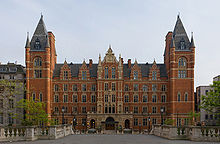 The front façade of the Royal College of Music
The front façade of the Royal College of Music
London is home to five major medical schools – Barts and The London School of Medicine and Dentistry (part of Queen Mary), King's College London School of Medicine and Dentistry (the largest medical school in Europe), Imperial College School of Medicine, UCL Medical School and St George's, University of London – and has a large number of affiliated teaching hospitals. It is also a major centre for biomedical research, and three of the UK's five academic health science centres are based in the city – Imperial College Healthcare, King's Health Partners and UCL Partners (the largest such centre in Europe).[202] There are a number of business schools in London, including Cass Business School (part of City University London), ESCP Europe, European Business School London, Imperial College Business School and the London Business School. London is also home to many specialist arts education institutions, including the Academy of Live and Recorded Arts, the London Contemporary Dance School, RADA, the Royal College of Art, the Royal College of Music and Trinity Laban.
Primary and secondary education
The majority of primary and secondary schools in London are state schools and are controlled by the London boroughs, although there are also a number of private schools in London, including old and famous schools such as the City of London School, Harrow, St Paul's School, University College School, Highgate School and Westminster School.
Culture
Main article: Culture of LondonAccent
The London accent long ago acquired the Cockney label, and was similar to many accents of the South East of England. The accent of a 21st century 'Londoner' varies widely; what is becoming more and more common amongst the under 30s however is some fusion of Cockney, Received Pronunciation, and a whole array of 'ethnic' accents, in particular Caribbean, which form an accent labelled Multicultural London English (MLE).[203]
Leisure and entertainment
Main articles: List of annual events in London and West End theatreWithin the City of Westminster, the entertainment district of the West End has its focus around Leicester Square, where London and world film premieres are held, and Piccadilly Circus, with its giant electronic advertisements.[204] London's theatre district is here, as are many cinemas, bars, clubs and restaurants, including the city's Chinatown district (in Soho), and just to the east is Covent Garden, an area housing speciality shops. The United Kingdom's Royal Ballet, English National Ballet, Royal Opera and English National Opera are based in London and perform at the Royal Opera House, the London Coliseum, Sadler's Wells Theatre and the Royal Albert Hall as well as touring the country.[205]
Islington's 1 mile (1.6 km) long Upper Street, extending northwards from the Angel, has more bars and restaurants than any other street in the United Kingdom.[206] Europe's busiest shopping area is Oxford Street, a shopping street nearly 1 mile (1.6 km) long, making it the longest shopping street in the United Kingdom. Oxford Street is home to vast numbers of retailers and department stores, including the world-famous Selfridges flagship store.[207] Knightsbridge, home to the equally renowned Harrods department store, lies to the southwest.
London is home to designers Vivienne Westwood, Galliano, Stella McCartney, Manolo Blahnik, and Jimmy Choo among others; its renowned art and fashion schools make it an international centre of fashion alongside Paris, Milan and New York. London offers a great variety of cuisine as a result of its ethnically diverse population. Gastronomic centres include the Bangladeshi restaurants of Brick Lane and the Chinese food restaurants of Chinatown.[208]
There are a variety of regular annual events in the city. The beginning of the year is celebrated with the relatively new New Year's Day Parade, fireworks display at the London Eye, and the world's second largest street party, the Notting Hill Carnival is held during the late August Bank holiday each year. Traditional parades include November's Lord Mayor's Show, a centuries-old event celebrating the annual appointment of a new Lord Mayor of the City of London with a procession along the streets of the City, and June's Trooping the Colour, a formal military pageant performed by regiments of the Commonwealth and British armies to celebrate the Queen's Official Birthday.[209]
Literature, film and television
Main articles: London in fiction, London in film, List of films set in London, and List of television shows set in London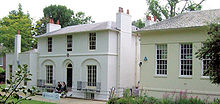 Keats House, where Keats wrote his Ode to a Nightingale. The village of Hampstead has historically been a literary centre in London.
Keats House, where Keats wrote his Ode to a Nightingale. The village of Hampstead has historically been a literary centre in London.
London has been the setting for many works of literature. The literary centres of London have traditionally been hilly Hampstead and (since the early 20th century) Bloomsbury. Writers closely associated with the city are the diarist Samuel Pepys, noted for his eyewitness account of the Great Fire, Charles Dickens, whose representation of a foggy, snowy, grimy London of street sweepers and pickpockets has been a major influence on people's vision of early Victorian London, and Virginia Woolf, regarded as one of the foremost modernist literary figures of the 20th century.[210]
The pilgrims in Geoffrey Chaucer's late 14th-century Canterbury Tales set out for Canterbury from London – specifically, from the Tabard inn, Southwark. William Shakespeare spent a large part of his life living and working in London; his contemporary Ben Jonson was also based there, and some of his work—most notably his play The Alchemist—was set in the city.[210] A Journal of the Plague Year (1722) by Daniel Defoe is a fictionalisation of the events of the 1665 Great Plague.[210] Later important depictions of London from the 19th and early 20th centuries are Dickens' novels, and Arthur Conan Doyle's Sherlock Holmes stories.[210] Modern writers pervasively influenced by the city include Peter Ackroyd, author of a "biography" of London, and Iain Sinclair, who writes in the genre of psychogeography.
London was the setting for the films Oliver Twist (1948), Peter Pan (1953), The Ladykillers (1955), The 101 Dalmatians (1961), Mary Poppins (1964), Blowup (1966), The Long Good Friday (1980), Secrets & Lies (1996), Notting Hill (1999), Match Point (2005), V For Vendetta (2005) and Sweeney Todd: The Demon Barber Of Fleet Street (2008). The television soap opera EastEnders, first broadcast in 1985, is also set in the city. London has played a significant role in the film industry, and has major studios at Ealing and a special effects and post-production community centred in Soho. Working Title Films has its headquarters in London.[211]
Museums and art galleries
Main article: List of museums in LondonThe British Museum.
London is home to many museums, galleries, and other institutions, many of which are free of admission charges and are major tourist attractions as well as playing a research role. The first of these to be established was the British Museum in Bloomsbury, in 1753. Originally containing antiquities, natural history specimens and the national library, the museum now has 7 million artefacts from around the globe. In 1824 the National Gallery was founded to house the British national collection of Western paintings; this now occupies a prominent position in Trafalgar Square. In the latter half of the nineteenth century the locale of South Kensington was developed as "Albertopolis", a cultural and scientific quarter. Three major national museums are located there: the Victoria and Albert Museum (for the applied arts), the Natural History Museum and the Science Museum. The national gallery of British art is at Tate Britain, originally established as an annexe of the National Gallery in 1897. The Tate Gallery, as it was formerly known, also became a major centre for modern art; in 2000 this collection moved to Tate Modern, a new gallery housed in the former Bankside Power Station.
Music
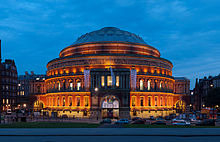 The Royal Albert Hall hosts concerts and musical events
The Royal Albert Hall hosts concerts and musical events
London is one of the major classical and popular music capitals of the world and is home to major music corporations, such as EMI, as well as countless bands, musicians and industry professionals. The city is also home to many orchestras and concert halls, such as the Barbican Arts Centre (principal base of the London Symphony Orchestra), Cadogan Hall (Royal Philharmonic Orchestra) and the Royal Albert Hall (The Proms).[205] London's two main opera houses are the Royal Opera House and the Coliseum Theatre.[205] The UK's largest pipe organ can be found at the Royal Albert Hall. Other significant instruments are found at the cathedrals and major churches. Several conservatoires are located within the city: Royal Academy of Music, Royal College of Music, Guildhall School of Music and Drama and Trinity College of Music.
London has numerous venues for rock and pop concerts, including large arenas such as Earls Court, Wembley Arena and the O2 Arena, as well as many mid-sized venues, such as Brixton Academy, Hammersmith Apollo and the Shepherd's Bush Empire.[205] Several music festivals, including the Wireless Festival, are held in London. The city is home to the first and original Hard Rock Cafe and the Abbey Road Studios where The Beatles recorded many of their hits. In the 1970s and 1980s, musicians and groups like Elton John, David Bowie, Queen, Elvis Costello, Cat Stevens, Ian Dury and the Blockheads, The Kinks, The Rolling Stones, The Who, Madness, The Jam, The Small Faces, Led Zeppelin, Iron Maiden, Fleetwood Mac, The Police, The Cure, Squeeze and Sade, took the world by storm, deriving their sound from the streets and rhythms vibrating through London.[212]
London was instrumental in the development of punk music,[213] with figures such as the Sex Pistols, The Clash,[212] and Vivienne Westwood all based in the city. More recent artists to emerge from the London music scene include Bananarama, Wham!, The Escape Club, Bush, East 17, Siouxsie and the Banshees, the Spice Girls, Jamiroquai, The Libertines, Babyshambles, Bloc Party, Amy Winehouse, Coldplay, and George Michael.[214] London is also a centre for urban music. In particular the genres UK garage, drum and bass, dubstep and grime evolved in the city from the foreign genres of hip hop and reggae, alongside local drum and bass. Black music station BBC 1Xtra was set up to support the rise of homegrown urban music both in London and the rest of the UK.
In the 1980s London was the main city in the New Wave of British Heavy Metal era which made bands like Iron Maiden and Motörhead famous worldwide. During the same decade, the city became influential in the New Wave and New Romantic movements, providing the background for acts like Culture Club, the Pet Shop Boys and Spandau Ballet.
Sports
Main article: Sport in LondonLondon has hosted the Summer Olympics twice, in 1908 and 1948.[215][216] In July 2005 London was chosen to host the Olympic and Paralympic Games in 2012, which will make it the first city in the world to host the Summer Olympics three times.[16] London was also the host of the British Empire Games in 1934.[217] London will host the 2017 World Championships in Athletics.[218] London's most popular sport is football and it has fourteen League football clubs, including five in the Premier League: Arsenal, Chelsea, Fulham, Queens Park Rangers and Tottenham Hotspur.[219]
London also has four rugby union teams in the Aviva Premiership (London Irish, Saracens, Wasps and Harlequins), although only the Harlequins play in London (all the other three now play outside Greater London, although Saracens still play within the M25).[220] The other professional rugby union team in the city is second division club London Welsh, that plays home matches in the city. The city has other very traditional rugby union clubs, famously London Scottish, Richmond F.C., Rosslyn Park F.C., Westcombe Park R.F.C. and Blackheath F.C..
There are currently three professional rugby league clubs in London – Harlequins Rugby League who play in the European Super League at The Stoop and the Championship One side the London Skolars (based in Wood Green, London Borough of Haringey) Hemel Stags based in Hemel Hempstead, north of London will play in the Championship One from 2013. Numbers for juniors playing the sport in the city are at an all time high with several earning full England caps at international level. In November 2011 Wembley Stadium will host a Gillette 4 Nations double-header including England v Australia and Wales v New Zealand.
From 1924, the original Wembley Stadium was the home of the English national football team, and served as the venue for the FA Cup final as well as rugby league's Challenge Cup final.[221] The new Wembley Stadium serves exactly the same purposes and has a capacity of 90,000.[222] Twickenham Stadium in south-west London is the national rugby union stadium, and has a capacity of 84,000 now that the new south stand has been completed.[223]
Cricket in London is served by two Test cricket grounds Lord's (home of Middlesex C.C.C) in St John's Wood[224] and the Oval (home of Surrey C.C.C) in Kennington.[225] Lord's has hosted four finals of the Cricket World Cup. One of London's best-known annual sports competitions is the Wimbledon Tennis Championships, held at the All England Club in the south-western suburb of Wimbledon.[226] Other key events are the annual mass-participation London Marathon which sees some 35,000 runners attempt a 26.2 miles (42.2 km) course around the city,[227] and the Oxford and Cambridge Boat Race on the River Thames between Putney and Mortlake.[228]
Twin cities
Main article: List of towns and cities twinned with LondonThere are 46 other places on six continents named after London.[229] As well as London's twinning, the London boroughs have twinnings with parts of other cities across the world. Shown below is the list of cities that the Greater London Authority has twinning arrangements with:
The following cities have a friendship agreement with London:
See also
Notes
- ^ According to the European Statistical Agency, London is the largest Larger Urban Zone which uses conurbations and areas of high population as its definition. A ranking of population within municipal boundaries places London first. However, the University of Avignon in France claims that Paris is first and London second when including the whole urban area and hinterland, that is the outlying cities as well.
- ^ See also: Independent city#National capitals.
- ^ According to the Collins English Dictionary definition of 'the seat of government',[85] London is not the capital of England, as England does not have its own government. According to the Oxford English Reference Dictionary definition of 'the most important town'[86] and many other authorities.[87]
References
- ^ (online) London, United Kingdom Forecast : Weather Underground (weather and elevation at Heathrow Airport). The Weather Underground, Inc.. Archived from the original on 19 May 2011. http://www.wunderground.com/global/stations/03772.html. Retrieved 6 June 2008.
- ^ a b July 2010 Population estimates for UK, England and Wales, Scotland and Northern Ireland. Office for National Statistics. http://www.statistics.gov.uk/downloads/theme_population/mid-2010-pop-ests-30-june-2011.zip. Retrieved 3 July 2011.
- ^ "Roman". The Museum of London. http://classic-web.archive.org/web/20080622181424/http://www.museumoflondon.org.uk/English/EventsExhibitions/Permanent/RomanLondon.htm. Retrieved 7 June 2008.
- ^ a b Mills 2001, p. 140
- ^ a b "Government Offices for the English Regions, Fact Files: London". Office for National Statistics. http://www.gos.gov.uk/gol/factgol/London/?a=42496. Retrieved 4 May 2008.[dead link]
- ^ Elcock, Howard (1994). Local Government: Policy and Management in Local Authorities. Routledge. p. 368. ISBN 978-0-415-10167-7.
- ^ Jones, Bill; Kavanagh, Dennis; Moran, Michael; Norton, Philip (2007). Politics UK. Pearson Education. p. 868. ISBN 978-1-4058-2411-8.
- ^ "Global Power City Index 2009". Institute for Urban Strategies – The Mori Memorial Foundation. http://www.mori-m-foundation.or.jp/english/research/project/6/pdf/GPCI2009_English.pdf. Retrieved 14 December 2010.
- ^ "Global Financial Centres 9". Z/Yen. 2011. http://www.zyen.com/GFCI/GFCI%209.pdf.
- ^ a b ""World's Most Economically Powerful Cities".". Forbes. 15 July 2008. Archived from the original on 19 May 2011. http://www.forbes.com/2008/07/15/economic-growth-gdp-biz-cx_jz_0715powercities.html. Retrieved 3 October 2010.
- ^ a b "Worldwide Centres of Commerce Index 2008". Mastercard. http://www.mastercard.com/us/company/en/insights/pdfs/2008/MCWW_WCoC-Report_2008.pdf.
- ^ "Global city GDP rankings 2008–2025". PricewaterhouseCoopers. Archived from the original on 19 May 2011. http://www.ukmediacentre.pwc.com/Media-Library/Global-city-GDP-rankings-2008-2025-61a.aspx. Retrieved 16 November 2010.
- ^ a b "Euromonitor International's Top City Destination Ranking (2011 update)". Euromonitor International. 6 January 2011. Archived from the original on 8 August 2011. http://blog.euromonitor.com/2011/01/euromonitor-internationals-top-city-destinations-ranking.html. Retrieved 8 August 2011.
- ^ a b "Delta Expects New Slots To Foster Growth At Heathrow Airport". The Wall Street Journal. 23 February 2011. Archived from the original on 19 May 2011. http://online.wsj.com/article/BT-CO-20110223-710213.html. Retrieved 7 March 2011.
- ^ a b "Number of international students in London continues to grow". Greater London Authority. Archived from the original on 19 May 2011. http://www.london.gov.uk/media/press_releases_mayoral/number-international-students-london-continues-grow. Retrieved 27 August 2010.
- ^ a b "IOC elects London as the Host City of the Games of the XXX Olympiad in 2012". International Olympic Committee. 6 July 2005. http://www.olympic.org/media?calendartab=1&articleid=52922. Retrieved 3 June 2006.
- ^ "Languages spoken in the UK population". CILT, the National Centre for Language. Archived from the original on 19 May 2011. http://www.cilt.org.uk/faqs/langspoken.htm. Retrieved 6 June 2008.
- ^ "Largest EU City. Over 7 million residents in 2001". www.statistics.gov.uk. Office for National Statistics. Archived from the original on 26 July 2007. http://www.statistics.gov.uk/cci/nugget.asp?id=384. Retrieved 28 June 2008.
- ^ a b "KS01 Usual resident population: Census 2001, Key Statistics for urban areas". Office for National Statistics. Archived from the original on 19 May 2011. http://www.statistics.gov.uk/statbase/ssdataset.asp?vlnk=8271&More=Y. Retrieved 6 June 2008.
- ^ "The Principal Agglomerations of the World". City Population. Archived from the original on 23 July 2010. http://www.citypopulation.de/world/Agglomerations.html. Retrieved 3 March 2009.
- ^ "Southest England Population by Area from 1891". Demographia. Archived from the original on 19 May 2011. http://www.demographia.com/dm-lonarea.htm. Retrieved 1 April 2009.
- ^ a b "London: The greatest city". Channel4.com. Archived from the original on 19 May 2011. http://www.channel4.com/history/microsites/H/history/i-m/london4.html. Retrieved 12 October 2008.
- ^ "Lists: United Kingdom of Great Britain and Northern Ireland". UNESCO. http://whc.unesco.org/en/statesparties/gb. Retrieved 26 November 2008.
- ^ "West End Must Innovate to Renovate, Says Report". What's On Stage. 25 January 2008. Archived from the original on 19 May 2011. http://www.whatsonstage.com/index.php?pg=207&story=E8821201275286&title=West+End+Must+Innovate+to+Renovate%2C+Says+Report. Retrieved 15 November 2010.
- ^ a b Transport for London. London Underground: History. ISBN 978-0-904711-30-1. http://www.tfl.gov.uk/corporate/modesoftransport/londonunderground/1604.aspx. Retrieved 6 June 2008.
- ^ a b "Shanghai now the world's longest metro". Railway Gazette International. 4 May 2010. Archived from the original on 19 May 2011. http://www.railwaygazette.com/news/single-view/view/10/shanghai-now-the-worlds-longest-metro.html. Retrieved 4 May 2010.
- ^ a b c d Mills 2001, p. 139
- ^ Ackroyd, Peter (2 December 2001). "'London'". New York Times. ISBN 978-0-7011-7279-4. http://www.nytimes.com/2001/12/02/books/chapters/02-1st-ackro.html?ex=1225339200&en=b9c2c11ad6e1f435&ei=5070&pagewanted=3. Retrieved 28 October 2008.
- ^ Coates, Richard (1998). "A new explanation of the name of London". Transactions of the Philological Society 96 (2): 203–229. doi:10.1111/1467-968X.00027. Archived from the original on 19 May 2011. http://www.blackwell-synergy.com/doi/pdf/10.1111/1467-968X.00027.
- ^ Perring, Dominic (1991). Roman London. London: Routledge. p. 1. ISBN 978-0-203-23133-3.
- ^ "British History Timeline —Roman Britain". British Broadcasting Corporation. Archived from the original on 19 May 2011. http://www.bbc.co.uk/history/british/timeline/romanbritain_timeline_noflash.shtml. Retrieved 7 June 2008.
- ^ a b "The early years of Lundenwic". The Museum of London. http://www.museumoflondon.org.uk/English/EventsExhibitions/Past/MissingLink/Themes/TML_themes_Lundenwic.htm. Retrieved 7 June 2008.[dead link]
- ^ a b "Viking and Danish London". The Museum of London. http://www.museumoflondon.org.uk/English/Collections/Onlineresources/RWWC/themes/1295/1288. Retrieved 6 June 2008.[dead link]
- ^ "Medieval London —Vikings". The Museum of London. http://classic-web.archive.org/web/20080602225909/http://www.museumoflondon.org.uk/English/EventsExhibitions/Permanent/medieval/Themes/1033/1035/default.htm. Retrieved 7 June 2008.
- ^ George Hamilton Cunningham (1927). London. J. M. Dent & Sons. p. xiii. http://books.google.com/?id=2fIgAAAAMAAJ.
- ^ Denison, Simon (July 1999). "First `London Bridge' in River Thames at Vauxhall". British Archaeology (46). Archived from the original on 19 May 2011. http://www.britarch.ac.uk/ba/ba46/ba46news.html. Retrieved 15 April 2011.
- ^ Milne, Gustav. "London's Oldest Foreshore Structure!". Frog Blog. Thames Discovery Programme. Archived from the original on 19 May 2011. http://www.thamesdiscovery.org/frog-blog/london-s-oldest-find-discovered-at-vauxhall. Retrieved 15 April 2011.
- ^ "Edward the Confessor (c.1003–1066)". British Broadcasting Corporation. Archived from the original on 19 May 2011. http://www.bbc.co.uk/history/historic_figures/edward_confessor.shtml. Retrieved 27 September 2008.
- ^ "History – 1066 – King William". BBC. Archived from the original on 19 May 2011. http://www.bbc.co.uk/history/british/normans/1066_06.shtml. Retrieved 5 May 2008.
- ^ Tinniswood, Adrian. "A History of British Architecture — White Tower". BBC. Archived from the original on 19 May 2011. http://www.bbc.co.uk/history/british/architecture_02.shtml. Retrieved 5 May 2008.
- ^ "UK Parliament — Parliament: The building". UK Parliament. 9 November 2007. Archived from the original on 11 March 2008. http://web.archive.org/web/20080311032051/http://www.parliament.uk/about/history/building.cfm. Retrieved 27 April 2008.
- ^ "Palace of Westminster". UK Parliament. Archived from the original on 4 April 2008. http://web.archive.org/web/20080404171249/http://www.parliament.uk/parliament/guide/palace.htm. Retrieved 27 April 2008.
- ^ Schofield, John; Vince, Alan (2003). Medieval Towns: The Archaeology of British Towns in Their European Setting. Continuum International Publishing Group. p. 26. ISBN 978-0-8264-6002-8. http://books.google.com/?id=Qu7QLC7g7VgC&pg=PA26&lpg=PA26&dq=london+population+1100+-+1300.
- ^ BBC – History – Black Death. BBC News. http://www.bbc.co.uk/history/british/middle_ages/black_01.shtml. Retrieved 3 November 2008.
- ^ "Richard II (1367–1400)". BBC. Archived from the original on 19 May 2011. http://www.bbc.co.uk/history/historic_figures/richard_ii_king.shtml. Retrieved 12 October 2008.
- ^ a b Nikolaus Pevsner, London I: The Cities of London and Westminster rev. edition,1962, Introduction p 48.
- ^ Durston, Christopher (1993). James I. London: Routledge. p. 59. ISBN 978-0-415-07779-8.
- ^ "A List of National Epidemics of Plague in England 1348–1665". Urbanrim.org.uk. 4 December 2009. Archived from the original on 3 May 2009. http://urbanrim.org.uk/plague%20list.htm. Retrieved 3 May 2010.
- ^ "Story of the plague". Channel 4.. Archived from the original on 19 May 2011. http://www.webcitation.org/5yo0bPVKk. Retrieved 2011-10-24.
- ^ Pepys, Samuel (2 September 1666) [1893]. The Diary of Samuel Pepys. 45: August/September 1666. ISBN 978-0-520-22167-3. Archived from the original on 19 May 2011. http://www.webcitation.org/5yo0bzHYi.
- ^ Schofield J (January 2001). "London After the Great Fire: Civil War and Revolution". BBC. Archived from the original on 19 May 2011. http://www.bbc.co.uk/history/british/civil_war_revolution/after_fire_02.shtml. Retrieved 28 April 2008.
- ^ "Museum of London — Rebuilding after the fire". Museum of London. Archived from the original on 1 February 2008. http://web.archive.org/web/20080201204641/http://www.museumoflondon.org.uk/English/EventsExhibitions/Special/LondonsBurning/Themes/1405/. Retrieved 27 April 2008.
- ^ The Rebuilding of London After the Great Fire. Thomas Fiddian. 1940. http://books.google.com/?id=jX8ZAAAAIAAJ&q=rebuilding+of+london&dq=rebuilding+of+london. Retrieved 27 April 2008.
- ^ The curious life of Robert Hooke, the man who measured London by Lisa Jardine
- ^ "Thief Taker, Constable, Police". Public Broadcasting Service (PBS).
- ^ Rough justice – Victorian style
- ^ National Affairs: Capital punishment: a fading practice
- ^ BBC – History – The Foundling Hospital
- ^ "When a man is tired of London, he is tired of life: Samuel Johnson". Archived from the original on 19 May 2011. http://www.samueljohnson.com/tiredlon.html.
- ^ Hidden extras: cholera comes to Victorian London
- ^ London in the Nineteenth Century
- ^ 7 July Bombings: Overview. London: BBC News. Archived from the original on 13 February 2007. http://news.bbc.co.uk/1/shared/spl/hi/uk/05/london_blasts/what_happened/html/default.stm. Retrieved 28 April 2008.
- ^ "About the Greater London Authority". London Government. Archived from the original on 19 May 2011. http://www.london.gov.uk/gla/. Retrieved 27 September 2008.
- ^ "Links to other websites — London boroughs". London Government. Archived from the original on 19 October 2007. http://web.archive.org/web/20071019055428/http://www.london.gov.uk/london/links.jsp. Retrieved 27 September 2008.
- ^ www.communities.gov.uk/documents/statistics/pdf/1911067.pdf
- ^ "Policing". Greater London Authority. Archived from the original on 21 January 2008. http://web.archive.org/web/20080121173357/http://www.london.gov.uk/gla/policing.jsp. Retrieved 25 August 2009.
- ^ "Areas". British Transport Police. Archived from the original on 19 May 2011. http://www.btp.police.uk/about_us/areas.aspx. Retrieved 25 August 2009.
- ^ "Who we are". London Fire Brigade. Archived from the original on 19 May 2011. http://www.london-fire.gov.uk/WhoWeAre.asp. Retrieved 25 August 2009.
- ^ "About us". London Ambulance Service NHS Trust. Archived from the original on 19 May 2011. http://www.londonambulance.nhs.uk/about_us.aspx. Retrieved 25 August 2009.
- ^ "Station list". Maritime and Coastguard Agency. 2007. Archived from the original on 19 May 2011. http://www.mcga.gov.uk/c4mca/mcga07-home/aboutus/mcga-online/mcga-sailing-cg66/dops_-_all-cg66-stationlist.htm. Retrieved 25 August 2009.
- ^ "Thames lifeboat service launched". BBC News. 2 January 2002. Archived from the original on 19 May 2011. http://news.bbc.co.uk/1/hi/england/1739401.stm. Retrieved 25 August 2009.
- ^ "10 Downing Street — Official Website". 10 Downing Street. Archived from the original on 10 May 2008. http://web.archive.org/web/20080510193022/http://www.number10.gov.uk/output/Page1.asp. Retrieved 26 April 2008.
- ^ "UK Politics: Talking Politics — The 'Mother of Parliaments'". BBC. 3 June 1998. Archived from the original on 19 May 2011. http://news.bbc.co.uk/1/hi/uk_politics/talking_politics/96021.stm. Retrieved 6 June 2008.
- ^ Beavan, Charles; Bickersteth, Harry (1865). Reports of Cases in Chancery, Argued and Determined in the Rolls Court. Saunders and Benning. http://books.google.com/?id=YFYDAAAAQAAJ.
- ^ Stationery Office (1980). The Inner London Letter Post. H.M.S.O. p. 128. ISBN 978-0-10-251580-0.
- ^ Geographers' A-Z Map Company (2008). London Postcode and Administrative Boundaries (6 ed.). Geographers' A-Z Map Company. ISBN 978-1-84348-592-6.
- ^ Mail, Royal (2004). Address Management Guide. Royal Mail.
- ^ "The Essex, Greater London and Hertfordshire (County and London Borough Boundaries) Order". Office of Public Sector Information. 1993. Archived from the original on 19 May 2011. http://www.opsi.gov.uk/SI/si1993/Uksi_19930441_en_1.htm. Retrieved 6 June 2008.
- ^ Dilys, M Hill (2000). Urban Policy and Politics in Britain. St. Martin's Press. p. 268. ISBN 978-0-312-22745-6.
- ^ "London in its Regional Setting (PDF)" (PDF). London Assembly. Archived from the original on 27 May 2008. http://web.archive.org/web/20080527193714/http://www.london.gov.uk/assembly/reports/plansd/london_regional_200104.pdf. Retrieved 6 June 2008.
- ^ London Government Act 1963. Office of Public Sector Information. ISBN 978-0-16-053895-7. Archived from the original on 19 May 2011. http://www.webcitation.org/5yo0mVCtM. Retrieved 6 May 2008.
- ^ "London — Features — Where is the Centre of London?". BBC. Archived from the original on 18 January 2010. http://www.bbc.co.uk/london/content/articles/2005/08/15/charingcross_feature.shtml. Retrieved 6 June 2008.
- ^ "Lieutenancies Act 1997". OPSI. Archived from the original on 19 May 2011. http://www.opsi.gov.uk/acts/acts1997/ukpga_19970023_en_1. Retrieved 7 June 2008.
- ^ Barlow, I. M. (1991). Metropolitan Government. Routledge. p. 346. ISBN Routledge.
- ^ (1994) Collins English Dictionary, Collins Education plc.
- ^ Oxford English Reference Dictionary, Oxford English.
- ^ "HC 501 0304.PDF" (PDF). Parliament Publications
- ^ Schofield, John (June 1999). British Archaeology Issue 45, June 1999. British Archaeology. ISSN 1357-4442. Archived from the original on 19 May 2011. http://www.britarch.ac.uk/BA/ba45/ba45regs.html. Retrieved 6 May 2008.
- ^ "Metropolis: 027 London, World Association of the Major Metropolises". http://www.dgcl.interieur.gouv.fr/sections/a_votre_service/lu_pour_vous/les_grandes_metropol/downloadFile/attachedFile/metropolislondres.pdf?nocache=1254397828.63. Retrieved 3 May 2010.
- ^ Sheppard, Francis (2000). London: A History. Google Books. p. 10. ISBN 978-0-19-285369-1. http://books.google.com/?id=M9qvtYYhRtAC&pg=PR11&dq=thames+%22iron+age%22+london+wide+geography+shallow+marsh. Retrieved 6 June 2008.
- ^ "Flooding". UK Environment Agency. Archived from the original on 15 February 2006. http://web.archive.org/web/20060215080725/http://www.environment-agency.gov.uk/yourenv/eff/1190084/natural_forces/flooding/?version=1&lang=_e. Retrieved 19 June 2006.
- ^ ""Sea Levels" – UK Environment Agency". Environment Agency. Archived from the original on 23 May 2008. http://web.archive.org/web/20080523225152/http://www.environment-agency.gov.uk/yourenv/eff/1190084/natural_forces/sealevels/?version=1&lang=_e. Retrieved 6 June 2008.
- ^ Adam, David (31 March 2009). "Thames Barrier gets extra time as London's main flood defence". The Guardian. UK. Archived from the original on 19 May 2011. http://www.guardian.co.uk/environment/2009/mar/31/thames-flood-barrier-london. Retrieved 7 November 2009.
- ^
The correct title of this article is The Weather Network. It appears incorrectly here because of technical restrictions.
- ^ "London, Greater London: Average conditions". BBC Weather. Archived from the original on 2011-02-28. http://www.webcitation.org/5wpjdyrKA.
- ^ "August 2003 — Hot spell". Met Office. Archived from the original on 2011-02-28. http://www.webcitation.org/5wpjI9SEw.
- ^ "Met Office: Climate averages 1971-2000". Met Office. Archived from the original on 2011-02-28. http://www.webcitation.org/5wpl3HnmR.
- ^ "NOAA". NOAA. ftp://dossier.ogp.noaa.gov/GCOS/WMO-Normals/RA-VI/UK/03776.TXT.
- ^ "London boroughs — London Life, GLA". London Government. Archived from the original on 13 December 2007. http://web.archive.org/web/20071213025156/http://www.london.gov.uk/london-life/city-government/boroughs.jsp. Retrieved 3 November 2008.
- ^ Dogan, Mattei; John D. Kasarda (1988). The Metropolis Era. Sage Publications. p. 99. ISBN 978-0-8039-2603-5. http://books.google.com/?id=_GFPAAAAMAAJ&q=1965,+32+boroughs+of+london&dq=1965,+32+boroughs+of+london.
- ^ "London as a financial centre". Mayor of London. Archived from the original on 6 January 2008. http://web.archive.org/web/20080106051217/http://www.london.gov.uk/london-life/business-and-jobs/financial-centre.jsp. Retrieved 6 May 2008.
- ^ "West End still drawing crowds". British Broadcasting Corporation. 22 October 2001. Archived from the original on 19 May 2011. http://news.bbc.co.uk/2/hi/entertainment/1608619.stm. Retrieved 6 June 2008.
- ^ Meek, James (17 April 2006). "Super Rich". London: The Guardian Money. Archived from the original on 19 May 2011. http://www.guardian.co.uk/money/2006/apr/17/tax.g2. Retrieved 7 June 2008.
- ^ "Price of Properties." (PDF). Royal Borough of Kensington and Chelsea. Archived from the original on 27 May 2008. http://web.archive.org/web/20080527193654/http://rbkc.gov.uk/Planning/localdevelopmentframework/ldf_hs_appendix_a2.pdf. Retrieved 6 June 2008.
- ^ a b "Tomorrow's East End". News Week. Archived from the original on 29 August 2006. http://web.archive.org/web/20060829024354/http://msnbc.msn.com/id/8487518/site/newsweek/. Retrieved 16 August 2007.
- ^ "History – British History in depth: Hampton Court: The Lost Palace". BBC. 17 February 2011. Archived from the original on 19 May 2011. http://www.bbc.co.uk/history/british/tudors/hampton_court_01.shtml. Retrieved 23 March 2011.
- ^ Paddington Station.. Great Buildings. Archived from the original on 19 May 2011. http://www.greatbuildings.com/buildings/Paddington_Station.html. Retrieved 6 June 2008.
- ^ "British Land, Blackstone To Build London HQ For UBS". Dow Jones Newswires. 2 August 2010. Archived from the original on 19 May 2011. http://www.lse.co.uk/sharecast-news-article.asp?ArticleCode=3610178&ArticleHeadline=UPDATE_British_Land_Blackstone_To_Build_London_HQ_For_UBS. Retrieved 26 April 2011.
- ^ Lonsdale, Sarah (27 March 2008). "Eco homes: Wooden it be lovely... ?". London: Telegraph Media Group Limited. Archived from the original on 19 May 2011. http://www.telegraph.co.uk/property/main.jhtml?view=DETAILS&grid=A1&xml=/property/2008/03/27/lpgreen127.xml. Retrieved 12 October 2008.
- ^ "Inside London's new 'glass egg'". British Broadcasting Corporation. 16 July 2002. Archived from the original on 19 May 2011. http://news.bbc.co.uk/1/hi/uk/2129199.stm. Retrieved 26 April 2008.
- ^ "Kensington Gardens". The Royal Parks. 2008. Archived from the original on 19 May 2011. http://www.royalparks.org.uk/parks/kensington_gardens/. Retrieved 26 April 2008.
- ^ "Madame Tussauds — Official website". Madame Tussauds. Archived from the original on 19 May 2011. http://www.madametussauds.com/London/About.aspx. Retrieved 6 June 2008.
- ^ "Madame Tussauds — Tourist Information". Tourist Information UK. Archived from the original on 19 May 2011. http://www.tourist-information-uk.com/madame-tussauds.htm. Retrieved 26 April 2008.
- ^ "Green Park". The Royal Parks. 2008. Archived from the original on 1 February 2010. http://www.royalparks.org.uk/parks/green_park/. Retrieved 26 April 2008.
- ^ "Greenwich Park". The Royal Parks. 2008. Archived from the original on 19 May 2011. http://www.royalparks.org.uk/parks/greenwich_park/. Retrieved 26 April 2008.
- ^ "Bushy Park". The Royal Parks. 2008. Archived from the original on 19 May 2011. http://www.royalparks.org.uk/parks/bushy_park/. Retrieved 26 April 2008.
- ^ "Richmond Park". The Royal Parks. 2008. Archived from the original on 19 May 2011. http://www.royalparks.org.uk/parks/richmond_park/. Retrieved 26 April 2008.
- ^ "City of London Corporation Hampstead Heath". City of London Corporation. Archived from the original on 19 May 2011. http://www.cityoflondon.gov.uk/Corporation/LGNL_Services/Environment_and_planning/Parks_and_open_spaces/Hampstead_Heath/. Retrieved 19 February 2010.
- ^ "Kenwood House". English Heritage. Archived from the original on 19 May 2011. http://www.english-heritage.org.uk/server/show/nav.00100200800k00800f. Retrieved 26 April 2008.
- ^ a b "A summary of countries of birth in London". Census Update (Greater London Authority Data Management Access Group) 2006/09: page 3. April 2006. Archived from the original on 2011-03-11. http://www.webcitation.org/5x7Dz2ITm. Retrieved 4 January 2011.
- ^ a b "Table 1.4: Estimated population resident in the United Kingdom, by foreign country of birth, July 2009 to June 2010". Office for National Statistics. http://www.statistics.gov.uk/downloads/theme_population/population-by-country-of-birth-and-nationality-jul09-jun10.zip. Retrieved 7 March 2011. Figure given is the central estimate. See the source for 95 per cent confidence intervals.
- ^ "T 08: Selected age groups for local authorities in the United Kingdom; estimated resident population; Mid-2007 Population Estimates" (XLS). www.statistics.gov.uk (Office for National Statistics). 21 August 2008. Archived from the original on 19 May 2011. http://www.statistics.gov.uk/downloads/theme_population/Mid_2007_UK_England_&_Wales_Scotland_and_Northern_Ireland%20_21_08_08.zip. Retrieved 26 January 2009.
- ^ "Southest England Population by Area from 1891". Demographia.com. Archived from the original on 19 May 2011. http://www.demographia.com/dm-lonarea.htm. Retrieved 13 September 2010.
- ^ Leppard, David (10 April 2005). "Immigration rise increases segregation in British cities". The Times (London). Archived from the original on 19 May 2011. http://www.timesonline.co.uk/tol/news/uk/article379434.ece. Retrieved 8 August 2009.
- ^ Metropolis World Association of the Major Metropolises. ISBN 978-0-7306-2020-4. http://www.dgcl.interieur.gouv.fr/sections/a_votre_service/lu_pour_vous/les_grandes_metropol/downloadFile/attachedFile/metropolislondres.pdf?nocache=1254397828.63. Retrieved 3 May 2010.
- ^ "Population density of London: by London borough, 2006" (PDF). UK Statistics Authority. http://www.statistics.gov.uk/downloads/theme_population/regional_snapshot/RS_Lon.pdf. Retrieved 7 June 2008.
- ^ "Forbes Magazine list of billionaires.". Forbes. 8 March 2007. Archived from the original on 19 May 2011. http://www.forbes.com/2007/03/07/billionaires-worlds-richest_07billionaires_cz_lk_af_0308billie_land.html. Retrieved 6 June 2008.
- ^ "CNN Money World's Most Expensive Cities 2004.". CNN. 11 June 2004. Archived from the original on 19 May 2011. http://money.cnn.com/2004/06/11/pf/costofliving/. Retrieved 16 August 2007.
- ^ "Resident Population Estimates by Ethnic Group (Percentages)". Neighbourhood Statistics. Office for National Statistics. Archived from the original on 19 May 2011. http://www.neighbourhood.statistics.gov.uk/dissemination/LeadTableView.do?a=7&b=276743&c=london&d=13&e=13&g=325264&i=1001x1003x1004&m=0&r=1&s=1280577856710&enc=1&dsFamilyId=1812. Retrieved 31 July 2010.
- ^ Graeme Paton (1 October 2007). "One fifth of children from ethnic minorities". The Daily Telegraph. London. Archived from the original on 15 June 2009. http://www.telegraph.co.uk/news/uknews/1564365/One-fifth-of-children-from-ethnic-minorities.html. Retrieved 7 June 2008.
- ^ Neighbourhood Statistics. "Check Browser Settings". Neighbourhood.statistics.gov.uk. http://www.neighbourhood.statistics.gov.uk/dissemination/LeadTableView.do?a=3&b=276743&c=London&d=13&e=13&g=325267&i=1001x1003x1004&o=322&m=0&r=1&s=1317478100328&enc=1&dsFamilyId=1809. Retrieved 2011-10-17.
- ^ Benedictus, Leo (21 January 2005). "London: Every race, colour, nation and religion on earth". Guardian. UK. Archived from the original on 19 May 2011. http://www.guardian.co.uk/uk/2005/jan/21/britishidentity1. Retrieved 6 May 2008.
- ^ "Census 2001: London". Office for National Statistics. Archived from the original on 19 May 2011. http://www.statistics.gov.uk/census2001/profiles/H-A.asp. Retrieved 3 June 2006.
- ^ Kyambi, Sarah (7 September 2005). Beyond Black and White: Mapping new immigrant communities. Institute for Public Policy Research. ISBN 978-1-86030-284-8. Archived from the original on 19 May 2011. http://www.webcitation.org/5yo11tc6i. Retrieved 20 January 2007.
- ^ a b "Census 2001 profiles: London". www.statistics.gov.uk. Office for National Statistics. Archived from the original on 19 May 2011. http://www.statistics.gov.uk/census2001/profiles/H-A.asp#ethnic. Retrieved 19 August 2008.
- ^ "About Saint Paul's Cathedral". Dean and Chapter St Paul's. Archived from the original on 7 April 2008. http://web.archive.org/web/20080407082352/http://www.stpauls.co.uk/page.aspx?theLang=001lngdef&pointerid=97320F44yHMK9hndcXZBD5sVH4m52Yc0. Retrieved 27 April 2008.
- ^ "Lambeth Palace Library". Lambeth Palace Library. Archived from the original on 19 May 2011. http://www.lambethpalacelibrary.org/. Retrieved 27 April 2008.
- ^ "Westminster Abbey". Dean and Chapter of Westminster. Archived from the original on 19 May 2011. http://www.westminster-abbey.org/. Retrieved 27 April 2008.
- ^ "West Minster Cathedral". Westminster Cathedral. Archived from the original on 27 March 2008. http://web.archive.org/web/20080327041736/http://www.westminstercathedral.org.uk/home.html. Retrieved 27 April 2008.
- ^ Church of England Statistics. Church of England. http://www.cofe.anglican.org/info/statistics/2007provisionalattendance.pdf. Retrieved 6 June 2008.
- ^ "London Central Mosque Trust Ltd". London Central Mosque Trust Ltd. & The Islamic Cultural Centre. Archived from the original on 19 May 2011. http://www.iccuk.org/index.php?article=1&PHPSESSID=rbt2vceqs1bpn9567k0kiv9hu5. Retrieved 27 April 2008.
- ^ "The $300 billion Arabs are coming". Evening Standard. UK. Archived from the original on 19 May 2011. http://www.thisislondon.co.uk/standard/article-23488244-the-300-billion-arabs-are-coming.do. Retrieved 3 May 2010.
- ^ "The Mecca of the West | 1970–1979 | Guardian Century". Google. Archived from the original on 19 May 2011. http://century.guardian.co.uk/1970-1979/Story/0,,106930,00.html. Retrieved 30 January 2011.
- ^ "Hindu London". British Broadcasting Corporation. 6 June 2005. Archived from the original on 18 February 2006. http://web.archive.org/web/20060218161357/http://www.bbc.co.uk/london/content/articles/2005/05/19/hindu_london_feature.shtml. Retrieved 3 June 2006.
- ^ "£17 m Sikh temple opens". British Broadcasting Corporation. 30 March 2003. Archived from the original on 19 May 2011. http://news.bbc.co.uk/1/hi/england/2898761.stm. Retrieved 7 June 2008.
- ^ "Jewish Agency". Jewish Agency. Archived from the original on 19 May 2011. http://www.jewishagency.org/JewishAgency/English/Israel/Partnerships/Regions/Kavimut/Britain+Communities/Stanmore+11.htm. Retrieved 12 October 2008.
- ^ Paul, Jonny. "Livingstone apologizes to UK's Jews | Jewish News | Jerusalem Post". Fr.jpost.com. Archived from the original on 19 May 2011. http://fr.jpost.com/servlet/Satellite?cid=1164881856232&pagename=JPost/JPArticle/ShowFull. Retrieved 5 February 2011.
- ^ "London's place in the UK economy, 2005–06" (PDF). City of London. http://www.cityoflondon.gov.uk/NR/rdonlyres/2CAE66FB-2DD5-41A5-B916-8FFC37276059/0/BC_RS_lpuk_0511_FR.pdf. Retrieved 11 March 2008.
- ^ "The Economic Positioning of Metropolitan Areas in North Western Europe" (PDF). The Institute for Urban Planning and Development of the Paris Île-de-France Region. December 2002. Archived from the original on 24 June 2008. http://web.archive.org/web/20080624195153/http://www.iaurif.org/en/doc/studies/cahiers/cahier_135/pdf/073-85.pdf. Retrieved 27 August 2008.
- ^ "After the fall". The Economist. 29 November 2007. Archived from the original on 19 May 2011. http://www.economist.com/finance/displaystory.cfm?story_id=E1_TDNDRPTT. Retrieved 2009=05-15.
- ^ "Financial Centres — Magnets for money". The Economist. 13 September 2007. Archived from the original on 19 May 2011. http://www.economist.com/specialreports/displaystory.cfm?story_id=9753240. Retrieved 15 May 2009.
- ^ "City of London mayor predicts 70,000 job cuts". The China Post. Taiwan (ROC). Archived from the original on 19 May 2011. http://www.chinapost.com.tw/business/europe/2008/11/27/185064/City-of.htm. Retrieved 4 January 2009.
- ^ "London Stock Exchange". London Stock Exchange plc.. 2008. Archived from the original on 19 May 2011. http://www.webcitation.org/5yo1FWjWx. Retrieved 27 April 2008.
- ^ "London's Place in the UK Economy, 2005–6" (PDF). Oxford Economic Forecasting on behalf of the Corporation of London. November 2005. p. 19. http://www.cityoflondon.gov.uk/NR/rdonlyres/2CAE66FB-2DD5-41A5-B916-8FFC37276059/0/BC_RS_lpuk_0511_FR.pdf. Retrieved 19 June 2006.
- ^ "London tops world cities spending league". Reuters. 17 February 2011. Archived from the original on 19 May 2011. http://uk.reuters.com/article/2011/02/17/uk-retail-major-cities-idUKLNE71G00420110217. Retrieved 29 April 2011.
- ^ a b "ARCHIVED CONTENT] Provisional Port Statistics 2009". Department for Tranport – Webarchive.nationalarchives.gov.uk. Archived from the original on 19 May 2011. http://webarchive.nationalarchives.gov.uk/+/http://www.dft.gov.uk/pgr/statistics/datatablespublications/maritime/ports/provportstats2009. Retrieved 26 April 2011.
- ^ "London is the HR centre of opportunity in the UK". PersonnelToday.com. 15 February 2005. Archived from the original on 19 May 2011. http://www.personneltoday.com/articles/2005/02/15/27958/london-is-the-hr-centre-of-opportunity-in-the-uk.html. Retrieved 3 June 2006.
- ^ ""The Importance of Tourism in London" (PDF). Archived from the original on 28 June 2007. http://web.archive.org/web/20070628053808/http://www.visitlondon.com/uploads/8551importanceoflondon_2004jun.pdf.", Visit London. Retrieved on 3 June 2006.
- ^ ""London 101: One Hundred and One Amazing Facts About London" (PDF). Archived from the original on 28 June 2007. http://web.archive.org/web/20070628053808/http://corporate.visitlondon.com/ems/downloads/8112london101.pdf.PDF (1.15 MiB)", Visit London. Retrieved on 3 June 2006.
- ^ "Top 10 London Attractions". Visit London. 1 April 2011. Archived from the original on 19 May 2011. http://www.visitlondon.com/attractions/culture/top-ten-attractions. Retrieved 26 April 2011.
- ^ "Transport for London". Transport for London. Archived from the original on 18 January 2010. http://www.tfl.gov.uk/. Retrieved 27 April 2008.
- ^ "London Cycling Campaign". Rosanna Downes. 20 November 2006. Archived from the original on 19 May 2011. http://www.lcc.org.uk/. Retrieved 27 April 2008.
- ^ "How do I find out about transport in London?". Greater London Authority. Archived from the original on 19 October 2007. http://web.archive.org/web/20071019055413/http://www.london.gov.uk/help/faq.jsp. Retrieved 5 June 2008.
- ^ "Year to date International Passenger Traffic November 2010". Airports Council International. 16 February 2011. Archived from the original on 10 March 2011. http://www.webcitation.org/5x5F2XC3a.
- ^ "BAA Heathrow: Official Website". BAA. http://www.heathrowairport.com/. Retrieved 27 April 2008.
- ^ "Heathrow Airport Terminal 5". TMC Ltd. Archived from the original on 19 May 2011. http://www.heathrow-airport-uk.info/heathrow-airport-terminal-5.htm. Retrieved 27 April 2008.
- ^ "Heathrow runway plans scrapped by new government". BBC News. 12 May 2010. Archived from the original on 19 May 2011. http://news.bbc.co.uk/1/hi/england/london/8678282.stm. Retrieved 30 January 2011.
- ^ "BAA Gatwick: Gatwick Airport". BAA. Archived from the original on 19 May 2011. http://www.gatwickairport.com/. Retrieved 27 April 2008.
- ^ BAA Stansted : Stansted Airport. BAA. 2008. ISBN 978-0-86039-476-1. Archived from the original on 19 May 2011. http://www.webcitation.org/5yo1JkALo. Retrieved 27 April 2008.
- ^ London Luton Airport. London Luton Airport. ISBN 978-0-11-510256-1. Archived from the original on 19 May 2011. http://www.webcitation.org/5yo1KGPZQ. Retrieved 27 April 2008.
- ^ "London City Airport — Corporate Information". London City Airport Ltd.. Archived from the original on 19 May 2011. http://www.londoncityairport.com/Default.aspx. Retrieved 6 June 2008.
- ^ Transport for London. London Buses. Transport for London. ISBN 978-0-946265-02-2. Archived from the original on 19 May 2011. http://www.webcitation.org/5yo1LaG15. Retrieved 6 June 2008.
- ^ "London's bus improvements get Parliamentary seal of approval". Transport For London. 23 May 2006. Archived from the original on 19 May 2011. http://www.tfl.gov.uk/static/corporate/media/newscentre/archive/3609.html. Retrieved 5 February 2011.
- ^ "London Black Cabs". London Black Cabs. Archived from the original on 19 May 2011. http://www.londonblackcabs.co.uk/. Retrieved 27 April 2008.
- ^ "Tube — Transport for London". Transport for London. Archived from the original on 19 May 2011. http://www.tfl.gov.uk/modalpages/2625.aspx. Retrieved 27 April 2008.
- ^ "Tramlink Factsheet". Transport for London. Summer 2009. Archived from the original on 11 March 2010. http://www.webcitation.org/5o8t78IGj. Retrieved 19 February 2010.
- ^ Key facts. Transport for London. http://www.tfl.gov.uk/corporate/modesoftransport/londonunderground/1608.aspx. Retrieved 15 October 2009.
- ^ Schwandl, Robert (2001). London Underground. UrbanRail.net. ISBN 978-3-936573-01-5. Archived from the original on 6 October 2006. http://web.archive.org/web/20061006013919/http://de.geocities.com/u_london/london.htm. Retrieved 24 September 2006.
- ^ "Tube breaks record for passenger numbers". Transport for London – Tfl.gov.uk. 27 December 2007. Archived from the original on 19 May 2011. http://www.tfl.gov.uk/static/corporate/media/newscentre/archive/7103.html. Retrieved 5 February 2011.
- ^ "London 2012 Olympic Transport Infrastructure." (PDF). Alarm UK. http://www.alarm-uk.org/pdf/Janet%20Goodland.pdf. Retrieved 6 June 2008.
- ^ London voted best for transport. London: BBC News. 29 August 2006. http://news.bbc.co.uk/2/hi/uk_news/england/london/5294790.stm.
- ^ "Rail Station Usage". Office of Rail Regulation. Archived from the original on 16 July 2007. http://www.rail-reg.gov.uk/server/show/nav.1529. Retrieved 24 October 2009.
- ^ "Tube exits". Tfl. Archived from the original on 22 July 2007. http://www.tfl.gov.uk/tfl/corporate/modesoftransport/tube/performance/default.asp?onload=entryexit. Retrieved 24 October 2009.
- ^ "First Capital Connect". First Capital Connect ltd. Archived from the original on 1 February 2010. http://www.webcitation.org/5nDd2BCwh. Retrieved 27 April 2008.
- ^ "Eurostar". Eurostar. Archived from the original on 19 May 2011. http://www.eurostar.com/dynamic/index.jsp;ERSPRDSession=LJqZB7nyKlW9lVLvZzK534LvMjL519fPDS4R0QGn51CprylVmjH8!685848002. Retrieved 6 June 2008.
- ^ "Highspeed". Southeastern. Archived from the original on 19 May 2011. http://www.southeasternrailway.co.uk/highspeed/. Retrieved 5 February 2011.
- ^ "Beds, Herts and Bucks Travel — All you need to know about the M25". BBC. 17 August 1988. Archived from the original on 19 May 2011. http://www.bbc.co.uk/threecounties/travel/m25/m25_facts.shtml. Retrieved 20 February 2010.
- ^ Charging Zone. Transport for London. Archived from the original on 19 May 2011. http://www.tfl.gov.uk/tfl/roadusers/congestioncharge/whereandwhen/. Retrieved 7 June 2008.
- ^ "Who pays what". Transport for London. Archived from the original on 8 June 2008. http://web.archive.org/web/20080608124006/http://www.tfl.gov.uk/roadusers/congestioncharging/6741.aspx. Retrieved 7 June 2008.
- ^ "Residents". Transport for London. Archived from the original on 19 May 2011. http://www.tfl.gov.uk/roadusers/congestioncharging/6735.aspx. Retrieved 7 June 2008.
- ^ Mulholland, Hélène (16 March 2009). "Boris Johnson mulls 'intelligent' congestion charge system for London". The Guardian. UK. Archived from the original on 19 May 2011. http://www.guardian.co.uk/politics/2009/mar/16/boris-johnson-congestion-charge. Retrieved 1 September 2009.
- ^ Santos, Georgina, Kenneth Button, and Roger G. Noll. "London Congestion Charging/Comments." Brookings-Wharton Papers on Urban Affairs.15287084 (2008): 177,177-234.
- ^ Table 3 in Santos, Georgina, Kenneth Button, and Roger G. Noll. "London Congestion Charging/Comments." Brookings-Wharton Papers on Urban Affairs.15287084 (2008): 177,177-234.
- ^ a b "Numbers of students in London". London Higher. Archived from the original on 19 May 2011. http://www.londonhigher.ac.uk/396.html?&no_cache=1&tx_ttnews%5Btt_news%5D=95&tx_ttnews%5BbackPid%5D=393&cHash=66a6e680d7. Retrieved 26 August 2010.
- ^ "QS World University Rankings Results 2011". QS Quacquarelli Symonds Limited. http://www.topuniversities.com/university-rankings/world-university-rankings. Retrieved 23 September 2010.
- ^ "The Sunday Times Good University Guide 2007 – Profile for London School of Economics". The Times (London). 23 September 2007. Archived from the original on 19 May 2011. http://www.timesonline.co.uk/tol/life_and_style/education/sunday_times_university_guide/article2496158.ece. Retrieved 6 June 2008.
- ^ "FT Global MBA Rankings". Financial Times. Archived from the original on 19 May 2011. http://rankings.ft.com/businessschoolrankings/global-mba-rankings. Retrieved 25 January 2010.
- ^ "About the University". University of London. 20 February 2006. Archived from the original on 19 May 2011. http://www.london.ac.uk/aboutus. Retrieved 3 June 2006.
- ^ "Colleges and Institutes". University of London. Archived from the original on 19 May 2011. http://www.london.ac.uk/colleges_institutes.html. Retrieved 23 September 2010.
- ^ About London Met London Metropolitan University, August 2008
- ^ "University of the Arts London". The Guardian (UK). 1 May 2008. Archived from the original on 19 May 2011. http://www.guardian.co.uk/education/2008/may/01/universityguide.highereducation42. Retrieved 27 August 2010.
- ^ Carvel, John (7 August 2008). "NHS hospitals to forge £2bn research link-up with university". The Guardian (UK). Archived from the original on 19 May 2011. http://www.guardian.co.uk/society/2008/aug/07/health.highereducation. Retrieved 6 September 2010.
- ^ Brown, Jonathan (11 April 2006). "Jafaican and Tikkiny drown out the East End's Cockney twang". The Independent (London). Archived from the original on 19 May 2011. http://www.independent.co.uk/news/uk/this-britain/jafaican-and-tikkiny-drown-out-the-east-ends-cockney-twang-473688.html. Retrieved 22 August 2008.
- ^ "Piccadilly Lights". Land Securities. Archived from the original on 19 May 2011. http://www.piccadillylights.co.uk/. Retrieved 3 November 2008.
- ^ a b c d "Theatres and concert halls.". Your London. Archived from the original on 24 January 2008. http://web.archive.org/web/20080124185332/http://www.yourlondon.gov.uk/visiting/topic.jsp?topicid=6482&search_title=Theatres+and+concert+halls. Retrieved 6 June 2008.
- ^ 2001: Public houses. British Broadcasting Corporation. Archived from the original on 19 May 2011. http://www.bbc.co.uk/history/trail/local_history/city/street_03.shtml?publichouses. Retrieved 4 June 2008.
- ^ Oxford Street gets its own dedicated local police team. The Londoner. September 2006. Archived from the original on 30 September 2007. http://web.archive.org/web/20070930204913/http://www.london.gov.uk/londoner/06sep/p7a.jsp. Retrieved 19 June 2007.
- ^ "Chinatown — Official website". Chinatown London. Archived from the original on 19 May 2011. http://www.chinatownlondon.org/. Retrieved 27 April 2008.
- ^ "One Queen, Two Birthdays". Royal Government. Archived from the original on 20 June 2008. http://web.archive.org/web/20080620233221/http://www.royal.gov.uk/output/Page4820.asp. Retrieved 27 September 2008.
- ^ a b c d "London in Literature,". Bryn Mawr College. Archived from the original on 19 May 2011. http://www.brynmawr.edu/library/speccoll/guides/london/londoninliterature.shtml. Retrieved 6 June 2008.
- ^ "Working Title Films". Universal Studios. Archived from the original on 19 May 2011. http://www.workingtitlefilms.com/. Retrieved 27 April 2008.
- ^ a b London's top 40 artists. British Broadcasting Corporation London. 6 April 2006. ISBN 978-0-89820-135-2. http://www.bbc.co.uk/london/content/articles/2006/04/06/garycrowley_londontop40_feature.shtml. Retrieved 9 September 2008.
- ^ "Punk". allmusic. http://www.allmusic.com/explore/style/d204. Retrieved 19 February 2010.
- ^ "History of music in London". The London Music Scene. Archived from the original on 19 May 2011. http://www.londonbc.co.uk/history-of-music-in-london.html. Retrieved 2 August 2009.
- ^ "London 1908". International Olympic Committee. Archived from the original on 19 May 2011. http://www.olympic.org/london-1908-summer-olympics. Retrieved 5 February 2011.
- ^ "London 1948". International Olympic Committee. Archived from the original on 19 May 2011. http://www.olympic.org/london-1948-summer-olympics. Retrieved 5 February 2011.
- ^ "England — Introduction". Commonwealth Games Federation. Archived from the original on 19 May 2011. http://www.thecgf.com/countries/intro.asp?loc=ENG. Retrieved 3 November 2008.
- ^ London Defeats Doha to host 2017 International Athletics Championships
- ^ "TheFA.com — Premier League". The FA.com. The Football Association. 17 January 2004. Archived from the original on 27 October 2004. http://web.archive.org/web/20041027030131/http://www.thefa.com/TheFA/ContactUs/Postings/2004/03/premier_league_contacts.htm. Retrieved 29 April 2008.
- ^ "Premiership Rugby: Clubs". Premier Rugby. Archived from the original on 19 May 2011. http://www.premiershiprugby.com/clubs/index.php. Retrieved 5 August 2010.
- ^ "Wembley Stadium History — Official Website". Wembley National Stadium Limited.. http://www.wembleystadium.com/GloriousPast/greatmoments/1steverwembleyFACupFinal.htm. Retrieved 29 April 2008.[dead link]
- ^ Wembley Stadium — Presspack — Facts and Figures. Wembley National Stadium Limited. http://www.wembleystadium.com/pressbox/presspack/factsandFigures.htm. Retrieved 6 June 2008.[dead link]
- ^ RFU apply for two additional concerts at Twickenham Stadium in 2007. The Twickenham Rugby Stadium. Archived from the original on 25 June 2008. http://web.archive.org/web/20080625050620/http://www.rfu.com/microsites/twickenham/index.cfm?StoryID=14822. Retrieved 6 June 2008.
- ^ "About Lord's—the home of cricket — official website". MCC. 2008. Archived from the original on 19 May 2011. http://www.lords.org/lords-ground/about-lords/. Retrieved 29 April 2008.
- ^ "The Brit Oval — Official Website". Surrey CCC. 2008. Archived from the original on 19 May 2011. http://www.surreycricket.com/the-brit-oval. Retrieved 29 April 2008.
- ^ "Wimbledon — official website". The All England Tennis and Croquet Club (AELTC). Archived from the original on 23 April 2008. http://web.archive.org/web/20080423182334/http://www.wimbledon.org/en_GB/index.html. Retrieved 29 April 2008.
- ^ "Flora London Marathon 2008". London Marathon ltd. Archived from the original on 26 April 2008. http://web.archive.org/web/20080426224024/http://www.london-marathon.co.uk/site/. Retrieved 29 April 2008.
- ^ "The Oxford and Cambridge Boat Race — Official Website". The Oxford and Cambridge Boat Race. Archived from the original on 19 May 2011. http://www.theboatrace.org/. Retrieved 29 April 2008.
- ^ Jack Malvern. Richmond, in Surrey, is the most widely copied British place name worldwide, timesonline 29 December 2008. The original byline for the article in The Times of the same day was "The 55 corners of foreign fields that will be for ever ... Richmond" (page 9). Cites The Times Universal Atlas of the World. http://www.webcitation.org/5yoKJBWF8
- ^ a b London is twinned with New York, Moscow and Berlin. "Interesting Facts About London". insideguide to London. http://www.inlondonguide.co.uk/london-sight-guide/interesting-facts-about-london.html London is twinned with New York, Moscow and Berlin.. Retrieved 27 July 2011.See Fact 2 by Big Ben photo.
- ^ a b "Friendship agreement to be signed between London and Delhi". Mayor of London. 25 July 2002. Archived from the original on 19 May 2011. http://legacy.london.gov.uk/view_press_release.jsp?releaseid=1329. Retrieved 23 February 2010.
- ^ "Twinning agreements". Making Joburg an entry point into Africa. City of Johannesburg. http://www.joburg.org.za/content/view/833/131/#ixzz0PU5ypfol. Retrieved 28 August 2009.[dead link]
- ^ Barfield, M (March 2001). "The New York City-London sister city partnership" (PDF). Greater London Authority. Archived from the original on 22 January 2010. http://www.webcitation.org/5mxnSYQPt. Retrieved 26 October 2009.
- ^ "Shanghai Foreign Affairs". Shfao.gov.cn. 27 July 2009. Archived from the original on 19 May 2011. http://www.shfao.gov.cn/wsb/english/Sister_Cities/u1a14240.html. Retrieved 23 May 2010.
- ^ "Beijing, London establish sister city ties". Gov.cn. 10 April 2006. Archived from the original on 19 May 2011. http://www.gov.cn/misc/2006-04/10/content_250542.htm. Retrieved 23 May 2010.
- ^ "Mayors of London and Dhaka, Bangladesh sign friendship agreement". Mayor of London. 10 September 2003. Archived from the original on 19 May 2011. http://legacy.london.gov.uk/view_press_release.jsp?releaseid=1971. Retrieved 23 February 2010.
- ^ "London, UK". Sister cities of Los Angeles, Inc.. Archived from the original on 19 May 2011. http://sistercitiesofla.com/page1/page57/page57.html. Retrieved 13 September 2010.
- ^ "Les pactes d'amitié et de coopération". Paris.fr. http://www.paris.fr/portail/politiques/Portal.lut?page_id=6587&document_type_id=5&document_id=16468&portlet_id=14974. Retrieved 23 May 2010.
Bibliography
- Ackroyd, Peter (2001). London: The Biography. London: Vintage. p. 880. ISBN 978-0-09-942258-7.
- Aubin, Robert Arnold (February 2008). "London in flames, London in glory: poems on the fire and rebuilding of London". The London Plan Spatial Development Strategy for Greater London Consolidated with Alterations since 2004 (Rutgers University Press). http://www.london.gov.uk/thelondonplan/docs/londonplan08.pdf.
- Miles, Barry (2010). London Calling. Atlantic Books. ISBN 978-1-84354-613-9.
- Mills, David (2001). Dictionary of London Place Names. Oxford Paperbacks. ISBN 978-0-19-280106-7. OCLC 45406491.
- Noorthouk, J (1773). A New History of London. Centre for Metropolitan History. http://www.british-history.ac.uk/source.aspx?pubid=332.
- Porter, Roy. History of London (1995), by a leading historian
- Reddaway, Thomas Fiddian (1940). The Rebuilding of London After the Great Fire. Jonathan Cape.
- Travers, Tony (2004). The Politics of London. Palgrave. ISBN 978-1-86134-172-3.
External links
- British Pathé Digitalised archive containing hundreds of films of 20th century London
- London in British History Online, with links to numerous authoritative online sources
- VisitLondon.com – Official London site
- Office for National Statistics: Focus on London 2007 – compendium of official statistics
- Museum of London Group Portal – Home
- Transport for London (TfL) – city transport authority
- Map of Early Modern London Historical Map & Encyclopaedia of Shakespeare's London. Scholarly
- London.gov.uk – Official site for the government of London by the Greater London Authority covering the Office of Mayor of London and the London Assembly
 OpenStreetMap has geographic data related to London
OpenStreetMap has geographic data related to London- The London Wiki
London in other topics  25 largest settlements in the UK by urban core population*
25 largest settlements in the UK by urban core population*- London: 7,172,091
- Birmingham: 970,892
- Glasgow: 629,501
- Liverpool: 469,017
- Leeds: 443,247
- Sheffield: 439,866
- Edinburgh: 430,082
- Bristol: 420,556
- Manchester: 394,269
- Leicester: 330,574
- Coventry: 303,475
- Kingston-upon-Hull: 301,416
- Bradford: 293,717
- Cardiff: 292,150
- Belfast: 276,459
- Stoke-on-Trent: 259,252
- Wolverhampton: 251,462
- Nottingham: 249,584
- Plymouth: 243,795
- Southampton: 234,224
- Reading: 232,662
- Derby: 229,407
- Dudley: 194,619
- Newcastle upon Tyne: 189,863
- Northampton: 189,474
*Based on 2001 Census data.Capitals of European states and territories Western Northern Central Southern Eastern Amsterdam, 6 Netherlands
Andorra la Vella, Andorra
Belfast, Northern Ireland
Brussels, 5 Belgium
Douglas, Isle of Man 4
Cardiff, Wales
Dublin, Ireland
Edinburgh, Scotland
Lisbon, Portugal
London, United Kingdom, England
Luxembourg, Luxembourg
Madrid, Spain
Monaco, Monaco
Paris, France
Saint Helier, Jersey 4
Saint Peter Port, Guernsey 4Ankara, Turkey 1
Athens, Greece
Gibraltar, Gibraltar 4
Nicosia, Cyprus 2
North Nicosia, Northern Cyprus 2, 3
Podgorica, Montenegro
Pristina, Kosovo 3
Rome, Italy
San Marino, San Marino
Sarajevo, Bosnia and Herzegovina
Skopje, Republic of Macedonia
Sofia, Bulgaria
Tirana, Albania
Valletta, Malta
Vatican City, Vatican CityAstana, Kazakhstan 1
Baku, Azerbaijan 1
Bucharest, Romania
Chişinău, Moldova
Kiev, Ukraine
Minsk, Belarus
Moscow, Russia 1
Stepanakert, Nagorno-Karabakh 2, 3
Sukhumi, Abkhazia 2, 3
Tbilisi, Georgia 1
Tiraspol, Transnistria 3
Tskhinvali, South Ossetia 2, 3
Yerevan, Armenia 11 Transcontinental country. 2 Entirely in Southwest Asia but having socio-political connections with Europe. 3 Partially recognised country. 4 Crown Dependency or Overseas Territory of the United Kingdom. 5 Also the seat of the European Union, see Location of European Union institutions and Brussels and the European Union. 6 Also the capital of the Kingdom of the Netherlands. 7 Also the capital of the Kingdom of Denmark.British Overseas Territories Crown Dependencies Constituent countries The Valley, Anguilla
Hamilton, Bermuda
Rothera, British Antarctic Territory
Diego Garcia, British Indian Ocean Territory
Road Town, British Virgin Islands
George Town, Cayman Islands
Stanley, Falkland Islands
Gibraltar, Gibraltar
Plymouth (de jure), Brades (de facto), Montserrat
Adamstown, Pitcairn Islands
Jamestown, Saint Helena, Ascension and Tristan da Cunha
Grytviken (de jure), King Edward Point (de facto), Sth Georgia & Sth Sandwich Islands
Episkopi Cantonment, Sovereign Base Areas of Akrotiri and Dhekelia
Cockburn Town, Turks and Caicos IslandsSaint Helier, Jersey
Saint Peter Port, Guernsey
Douglas, Isle of ManLondon, England and the United Kingdom
Edinburgh, Scotland
Cardiff, Wales
Belfast, Northern IrelandWorld's twenty most populous metropolitan areas 6
 Jakarta
Jakarta
7 São Paulo
São Paulo
8 Delhi
Delhi
9 Keihanshin
Keihanshin
10 Shanghai
Shanghai16
 Cairo
Cairo
17 Buenos Aires
Buenos Aires
18 London
London
19 Beijing
Beijing
20 Karachi
KarachiWorld's fifty most-populous urban areas - Bogotá
- London
- Taipei
- Ho Chi Minh City
- Chennai
- Johannesburg –East Rand
- Bangalore
- Lahore
- Tehran
- Ruhr Area
(Essen–Düsseldorf)
Summer Olympic Games host cities 1896:
 Athens • 1900:
Athens • 1900:  Paris • 1904:
Paris • 1904:  St. Louis • 1908:
St. Louis • 1908:  London • 1912:
London • 1912:  Stockholm • 1920:
Stockholm • 1920:  Antwerp • 1924:
Antwerp • 1924:  Paris • 1928:
Paris • 1928:  Amsterdam • 1932:
Amsterdam • 1932:  Los Angeles • 1936:
Los Angeles • 1936:  Berlin • 1940: cancelled • 1944: cancelled • 1948:
Berlin • 1940: cancelled • 1944: cancelled • 1948:  London • 1952:
London • 1952:  Helsinki • 1956:
Helsinki • 1956:  Melbourne • 1960:
Melbourne • 1960:  Rome • 1964:
Rome • 1964:  Tokyo • 1968:
Tokyo • 1968:  Mexico City • 1972:
Mexico City • 1972:  Munich • 1976:
Munich • 1976:  Montreal • 1980:
Montreal • 1980:  Moscow • 1984:
Moscow • 1984:  Los Angeles • 1988:
Los Angeles • 1988:  Seoul • 1992:
Seoul • 1992:  Barcelona • 1996:
Barcelona • 1996:  Atlanta • 2000:
Atlanta • 2000:  Sydney • 2004:
Sydney • 2004:  Athens • 2008:
Athens • 2008:  Beijing • 2012:
Beijing • 2012:  London • 2016:
London • 2016:  Rio de Janeiro
Rio de JaneiroSummer Paralympic Games host cities Commonwealth Games host cities 1930: Hamilton • 1934: London • 1938: Sydney • 1950: Auckland • 1954: Vancouver • 1958: Cardiff • 1962: Perth • 1966: Kingston • 1970: Edinburgh • 1974: Christchurch • 1978: Edmonton • 1982: Brisbane • 1986: Edinburgh • 1990: Auckland • 1994: Victoria • 1998: Kuala Lumpur • 2002: Manchester • 2006: Melbourne • 2010: Delhi • 2014: Glasgow • 2018: "Gold Coast •
Template:WWII city bombing Template:Hanseatic League Template:Navboxes Template:Good article Template:Use dmy datesTemplate:Link FA Template:Link FA Template:Link FA Template:Link GA Template:Link GA Template:Link GA
Categories:- Host cities of the Summer Olympic Games
- Summer Paralympic Games
- Host cities of the Commonwealth Games
- London
- Arthurian locations
- British capitals
- Capitals in Europe
- Populated places established in the 1st century
- Port cities and towns in the United Kingdom
- Robin Hood locations
- Staple ports
Wikimedia Foundation. 2010.

